Similar Posts
The rector, Fr. Dominique Verbeke, and his counsel, asked me to present a proposal on the occasion of the 50th anniversary of the founding of the Orthodox parish of the Holy Apostle Andrew in Ghent, Belgium. I was to decorate the ‘first church’, a big room in a house of the Old Beguinage (17th century) of Ghent, where the founder of the parish, Archpriest Ignace Peckstadt, started the community. It is called the first church because the parish was later moved into a bigger church on the other side of the road.
The Program
The ‘first church’ is still regularly used for Vespers services on Saturdays and Wednesdays, for the liturgy of the Presanctified Gifts in Lent and for baptisms. It was obvious that the decoration should reflect these liturgical services.
A space of 50 square meters had to be filled. By making alterations to the chimney, a niche was created to hold the baptismal font. It came quite naturally to develop the theme of baptism on the walls. In the center and above the font you can see the Baptism of Christ. It is surrounded by two Old-Testament prefigurations: the crossing of the Red Sea and the story of Jonah; and by two New-Testament scenes: the Blind-born and the Samaritan woman.
The walls on the side of the sanctuary were, as the tradition demands, decorated with the Annunciation. On the higher parts of the wall, you can see the angel on the left and the Virgin on the right. Beneath them you can find the Virgin Paraklesis on the left and Christ on the right. They are both standing. The walls leading to the iconostasis where filled with two hymnographers on the higher parts: Sts. John the Damascene and Kosmas of Maïouma. The lower parts hold the patron saint of the parish: St. Andrew, and the patron saint of the founder of the parish, Fr. Ignace Peckstadt.
The higher parts of the big wall on the right in which the entrance door is located, was decorated with the theme of the Pascal Mystery the Crucifixion, the Anastasis and the Myrrhbearing women The scenes were composed as a unity. Beneath them a choice of church-fathers from both the East and the West was painted: St. Basil the Great, St. John Chrysostom, St. Cyprian of Carthage and St. Ambrose of Milan. On the right side of the entrance door you can see three saints linked to the services of Lent : St. Ephrem, St Mary of Egypt and St. John of the Ladder.
On the opposite wall, between the windows, you can find two female saints of the early undivided church, a martyr and a monastic: St. Blandina of Lyon (2nd century) and St. Melania the Younger of Rome (4th-5th century). The bigger wall, closer to the iconostasis, was filled with two saints to whom the parish is very much indebted spiritually: the Sts. Siluan and Sophrony the Athonites. (In fact St. Sophrony once celebrated the Liturgy in the ‘first church’.)
Fresco Process
I started doing the 1:1 scale charcoal-drawings on paper in May 2020. The biggest scene, the Baptism of Christ, is 2.24 x 1.84 m (88.19 x 72.44 inch). I regularly hung the drawings on the walls to see the effect. This was the most creative part of the work; drawing in charcoal permits great spontaneity. In a second phase I had to transfer the drawings on tracing paper so I could then transfer the models onto the wet plaster.
I defined the harmony of colors by painting the drawings in tempera. The colors used were noted carefully. I had collected the pigments with great discernment. I chose a palette so that the result would not be too dominant. The frescos would have to create a balanced environment for liturgy: they would have to be modest and humble but lively at the same time. A lot of colors are ‘in between’, delicate, and far from the common choices. They are especially based on earthen and mineral pigments. The pigments were moulded and refined in order to obtain a maximum of absorption by the wet plaster.
After installing the work-place I started on the walls on the 21 September. There was always one other person helping me too, for example, mix plasters. Some of my pupils, and a young friend, an artist himself, did a wonderful job.
The walls were very carefully prepared. First, all the old plaster layers were removed after which they were made even with several thin layers of lime and coarse sand. This was done beforehand by craftsmen.
The work was set up according to a strict schedule: In the evening I would put an ‘arricio’ of two parts of finer (and dry) sand mixed with one part of lime putty on the bottom layer. The next morning a top layer consisting of one part lime putty, 1/2 part of very fine sand (quartz) and 1/2 part of marble dust was put on. This would be finished around 9:30am.
An hour later we were be able to transfer the drawing from the tracing paper. After that, I repeated the drawing in red ochre and started to fill it in with the colors, bringing in shades and lines, reinforcing the colors, ending with the light ones. We could paint until 3:30pm.
After a break I finished the day by preparing the ground layer for the next day. The big scenes were divided in two or mostly three ‘giornate’(working days). The next morning we started again at 7am The fresco work was regularly interrupted to complete the details and the lettering and to make corrections or refinements ‘in secco’ (tempera). I finished on the 31st of December, 2020.
Iconographic Training
After making some steps in art, drawing and painting, I turned towards the iconography of the Eastern churches. In 1975 Mr. Bernard Frinking, orthodox iconographer in Paris, was so kind as to help me with the first steps. In 1981 he introduced me to Leonid Ouspensky, under whose guiding I painted until his death in 1987. My family and I were able to make a living from my work as an iconographer thanks to catholic faithful and communities who showed a large interest for icons and the Eastern church in general. Especially the catholic monastic world ordered many large festal icons which were exposed solemnly during the liturgy. In 1998 an abbey asked me to give sessions in iconography, which I did for 20 years.
In 2012, I approached Fr. Patrick Doolan, of the St. Gregory of Sinaï monastery in California to introduce me in the fresco technique. I was received very kindly and stayed three weeks in the monastery where the fathers Patrick and Moses gave me good advice and taught me how to make portable frescoes.
In 2016, thanks to the suggestion of one of my orthodox pupils, I found my way into the Ecole Duperré in Paris where I perfected the fresco-technique under the guidance of Mrs. Isabelle Bonzom. This culminated into the decoration of the chapel apsis of the patristic institute of Ghent, which I founded together with Fr. Dominique of the Orthodox parish. Later, in 2018, I decorated the arch opening onto the apsis.
The friendship and collaboration with the Orthodox parish started in 2006 with the founding of the institute just mentioned but the friendship with Fr. Verbeke dates back to earlier times.
In 1992, I had the occasion to spend some days in the monastery of St. John the Baptist in Essex (St. Sophrony was still alive) and I made it a custom to return there each year. Notwithstanding the fact that I am Catholic, my work received honest approval and appreciation especially for the authenticity of my icons. A solid spiritual bond with the monastery has been established ever since.
Editors Note:
After delays caused by Covid, the ‘First Church’ in Ghent was re-opened to use, and rededicated in a ceremony on the 26th of February, 2022. The church received a second dedication due to its association with Fr. Sophrony, and is now known as the Church of Holy Apostle Andrew and Saint Sophrony the Athonite. Photos of the dedication service appear below.
If you enjoyed this article, please use the PayPal button below to donate to support the work of the Orthodox Arts Journal. The costs to maintain the website are considerable.
Addendum
- The composition scene of the Crossing of the Red Sea was inspired by a fresco in the catacomb of the Via Latina, Rome
- The scene of Jonah was inspired on the composition of the Jonah-sarcophagus in the Museums of the Vatican
- For the composition of the scenes of the Blind born and of the Samaritan woman I found inspiration in the romanesque frescos of the church of Sant Angelo in Formis (Italy, 12th century).
- The iconography of St. Blandina is derived from engravings of the 19th century and of the tympanum of the St. Blandinachurch in Lyon
- The iconography of St. Melania the Younger was found in the menologion of Basil II, 10th century
For the iconography of the Sts Siluan and Sophrony I followed the models of the monastery in Essex.
The festal scenes follow the traditional patterns. - The portraits of St. Basil and Chrysostom are traditional. A model for St. Cyprian was found in the Serbian church of Gracanica, that of St. Ambrose in the chapel of Vittorio al ciel d’oro in the basilica of St. Ambrose in Milan (5th century).

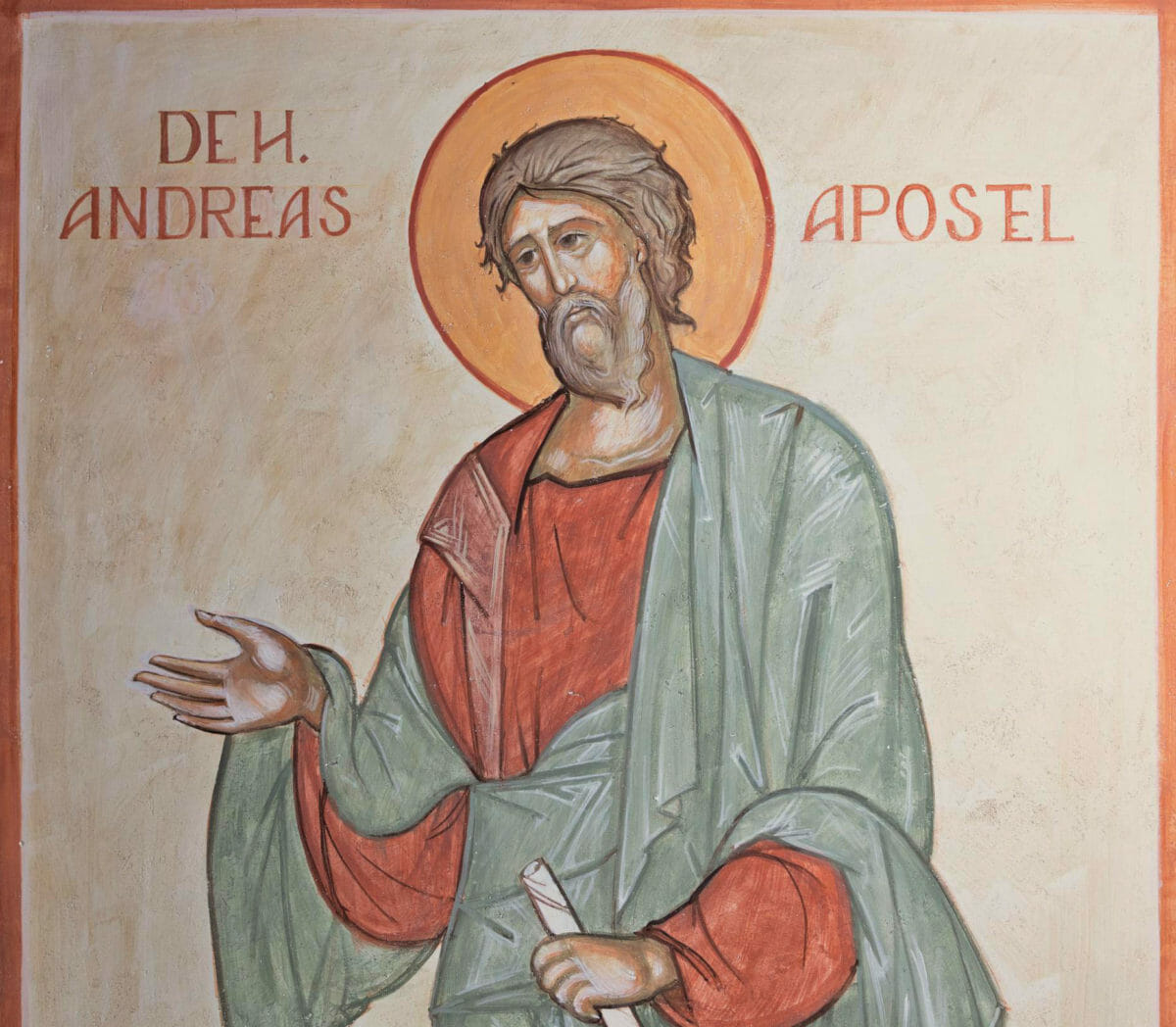
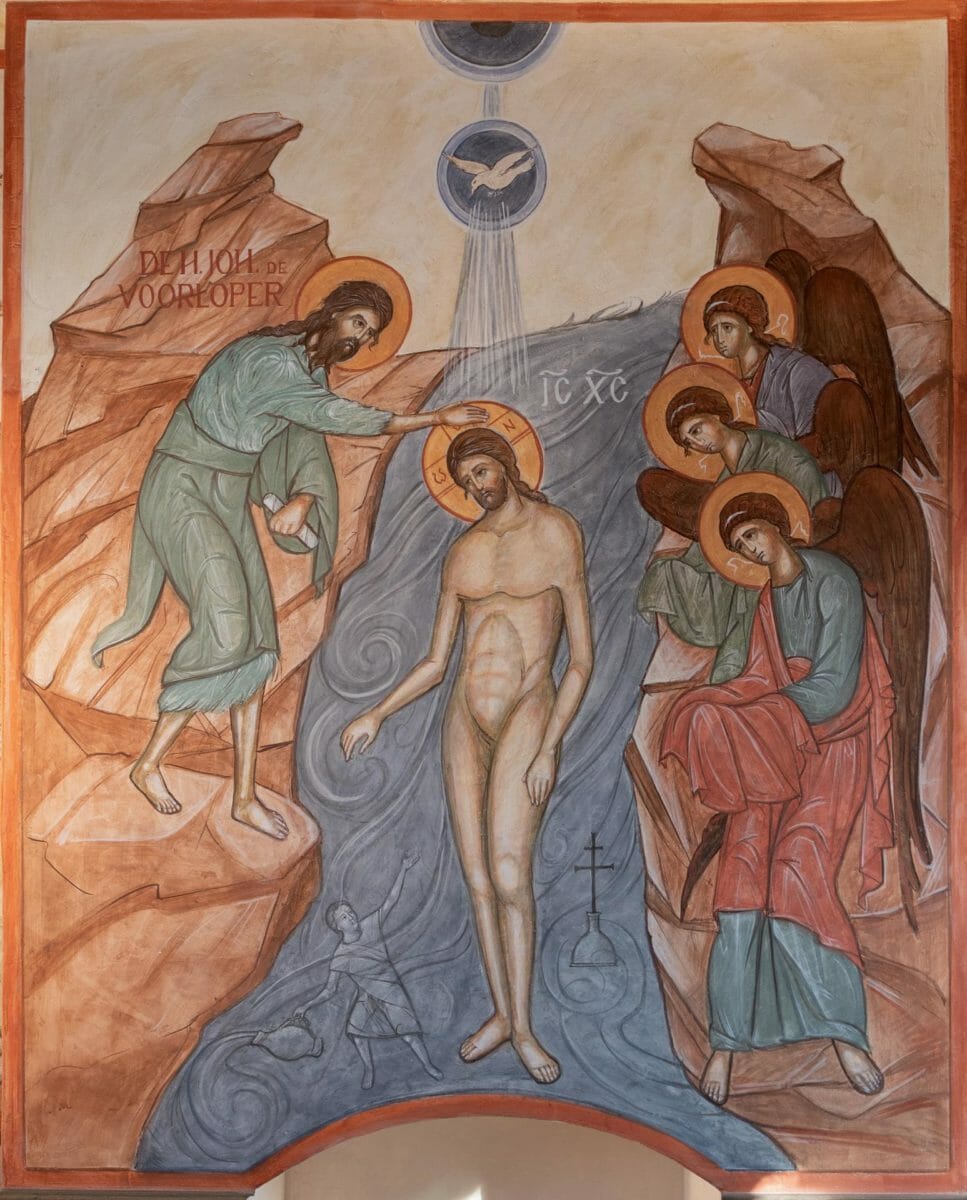

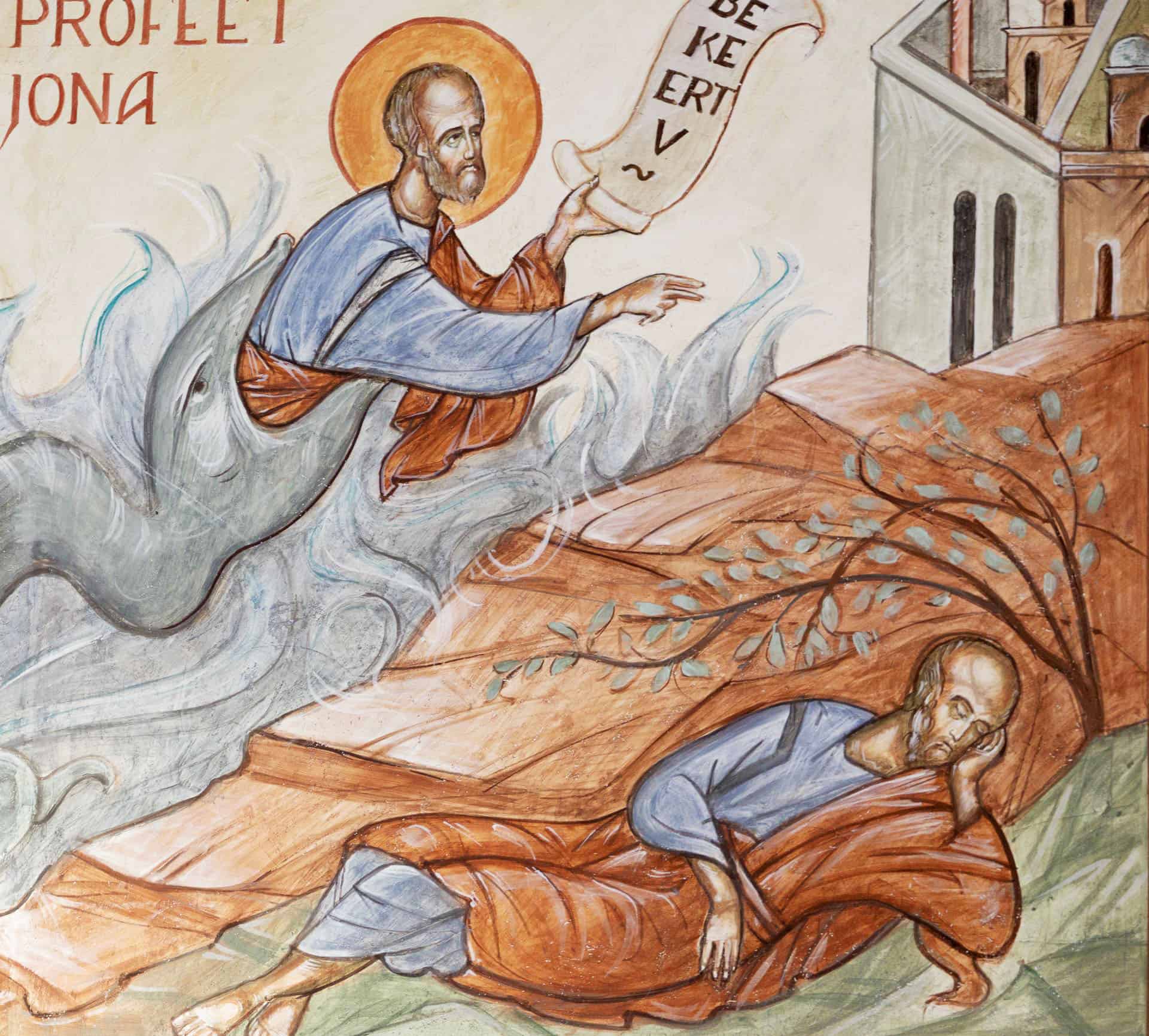


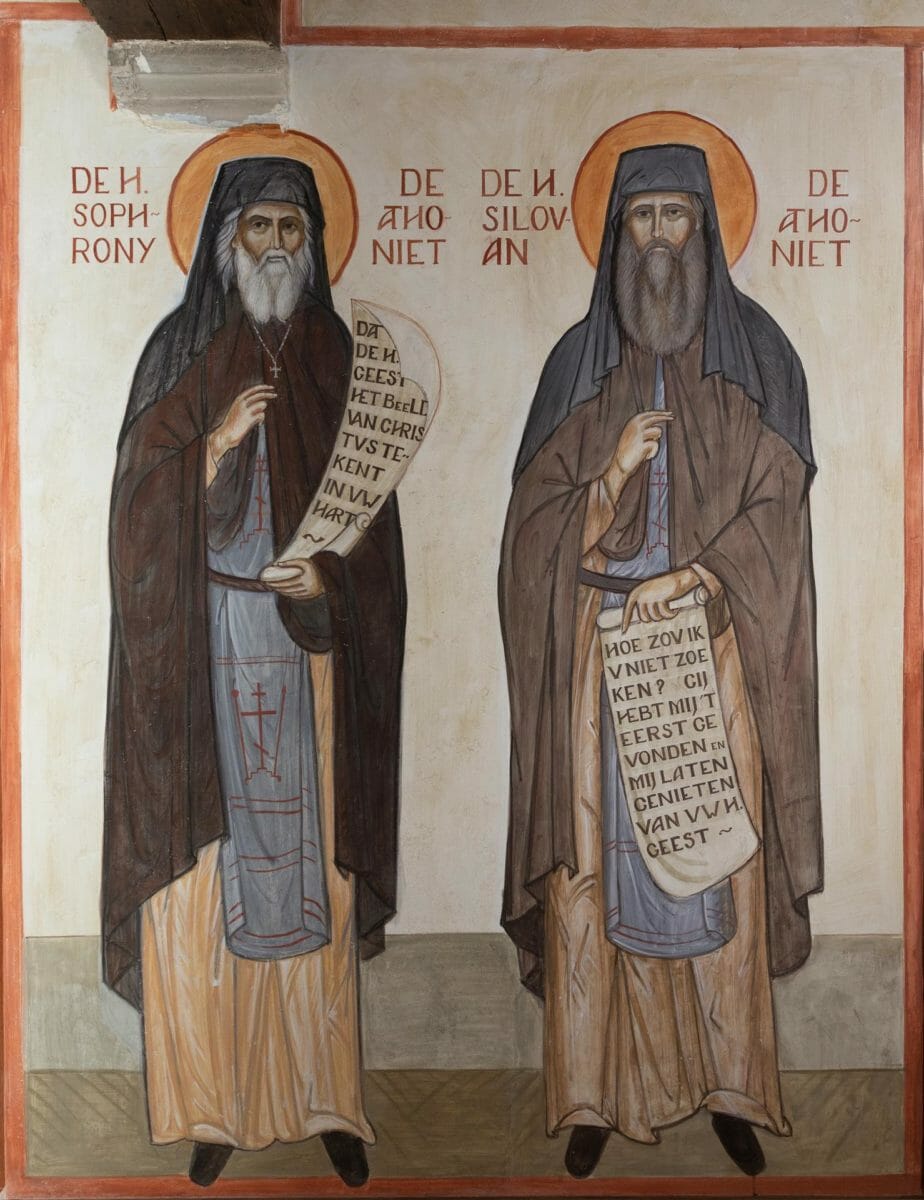
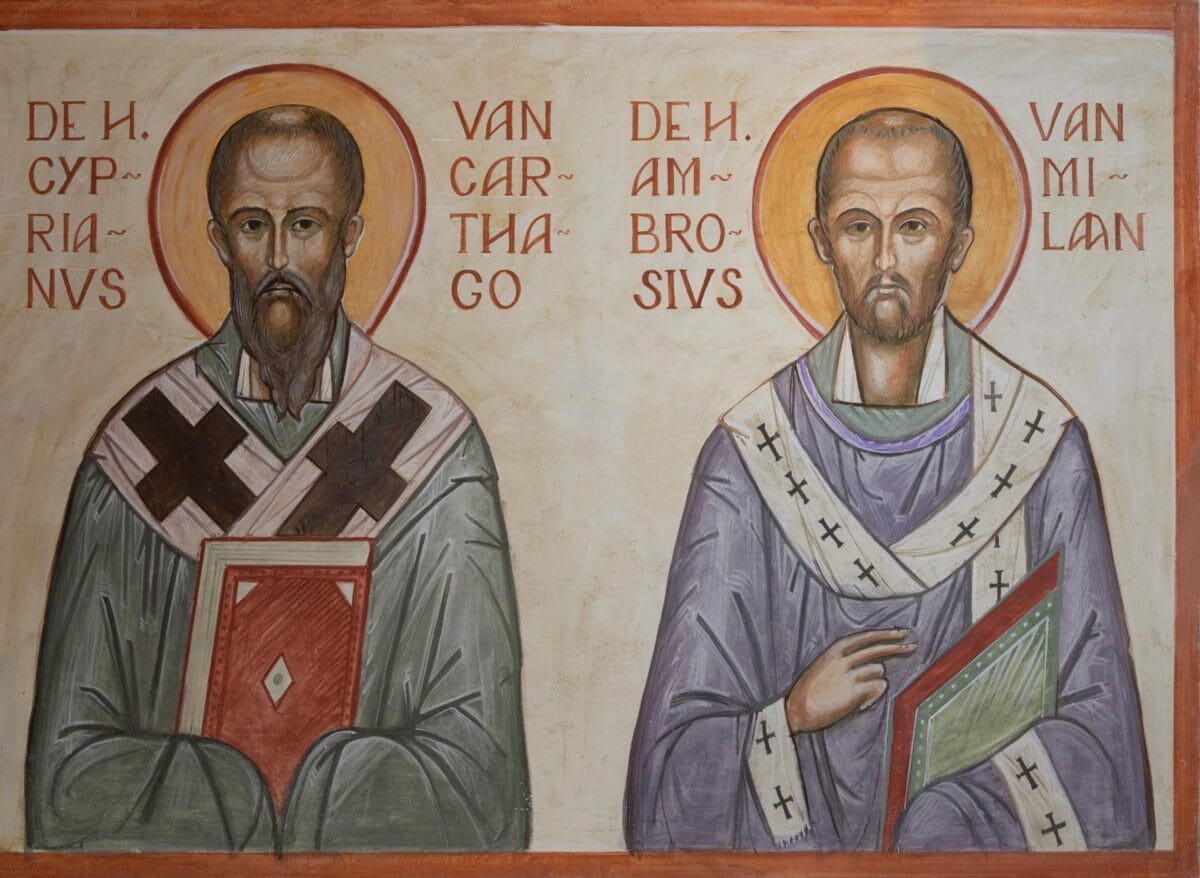
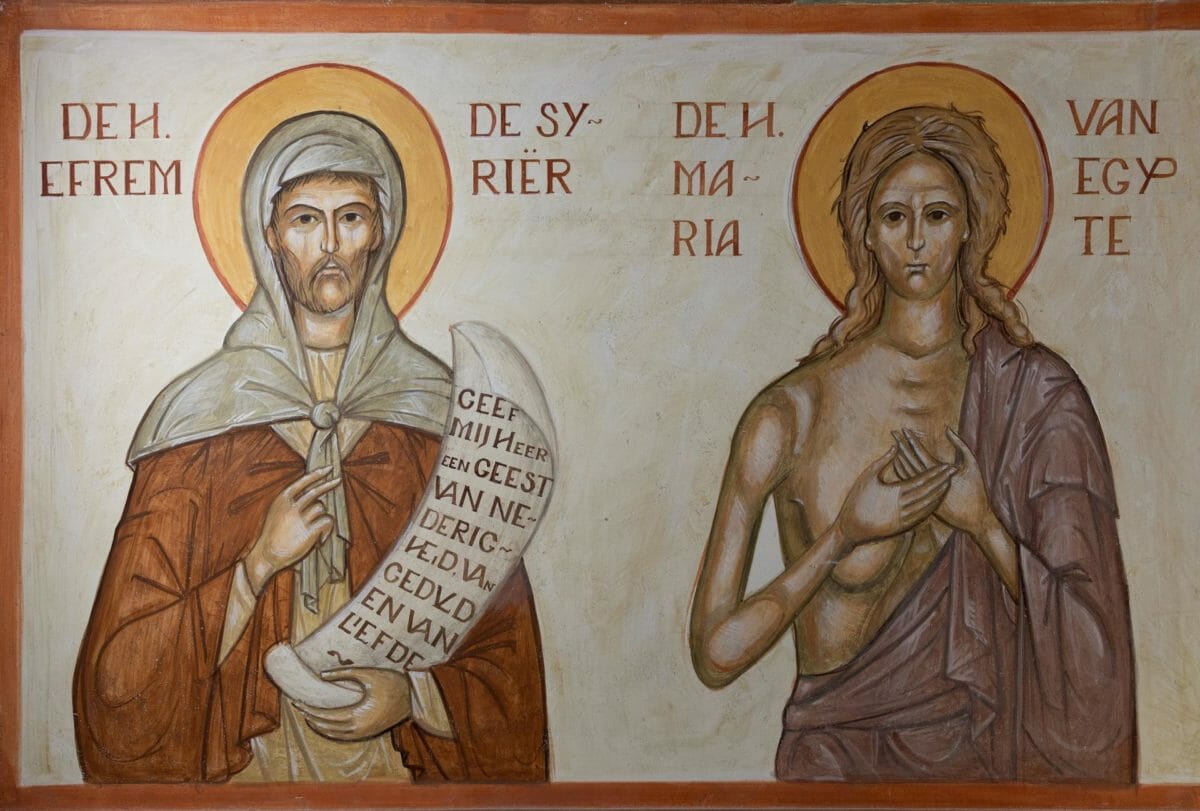
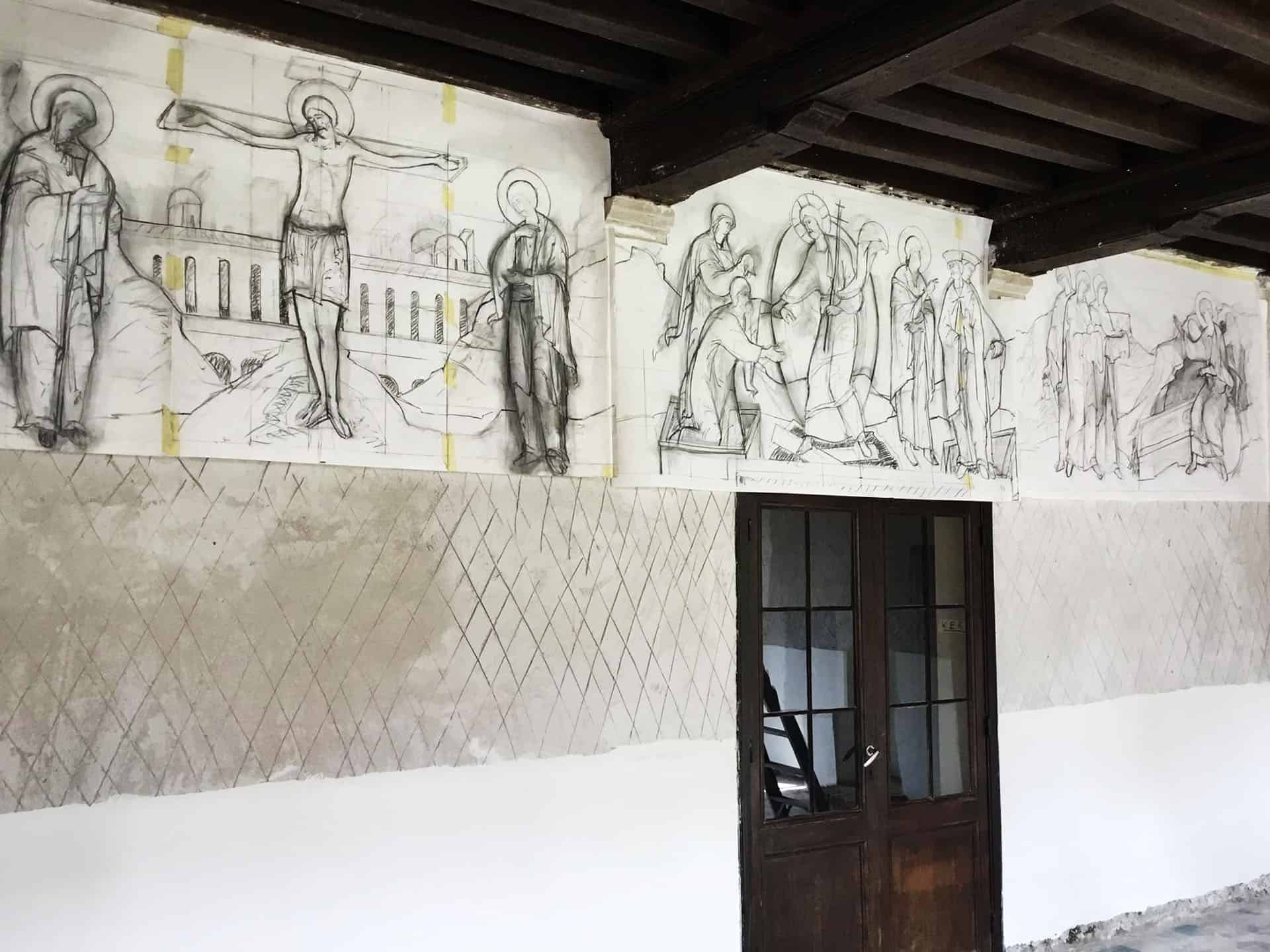
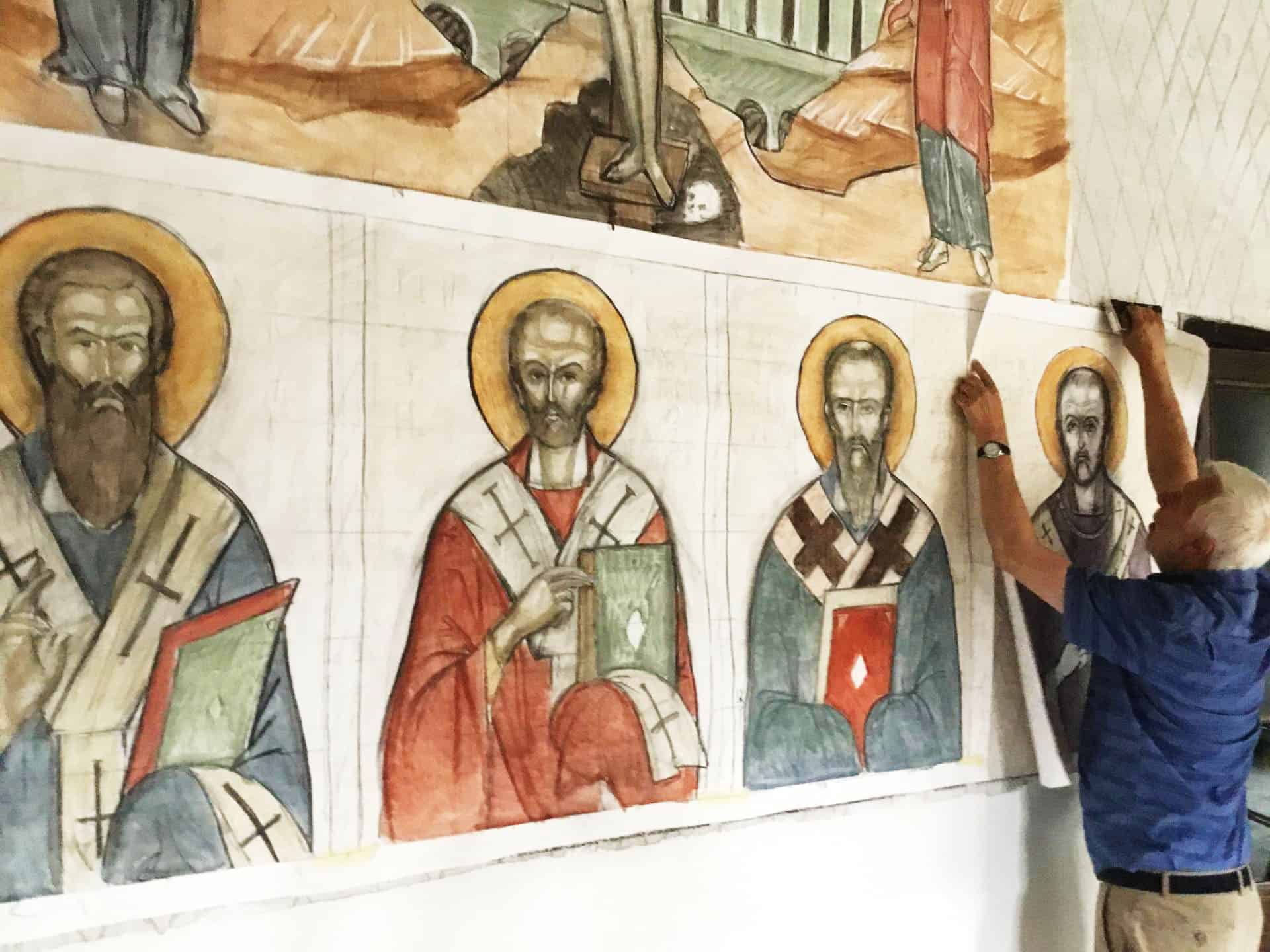
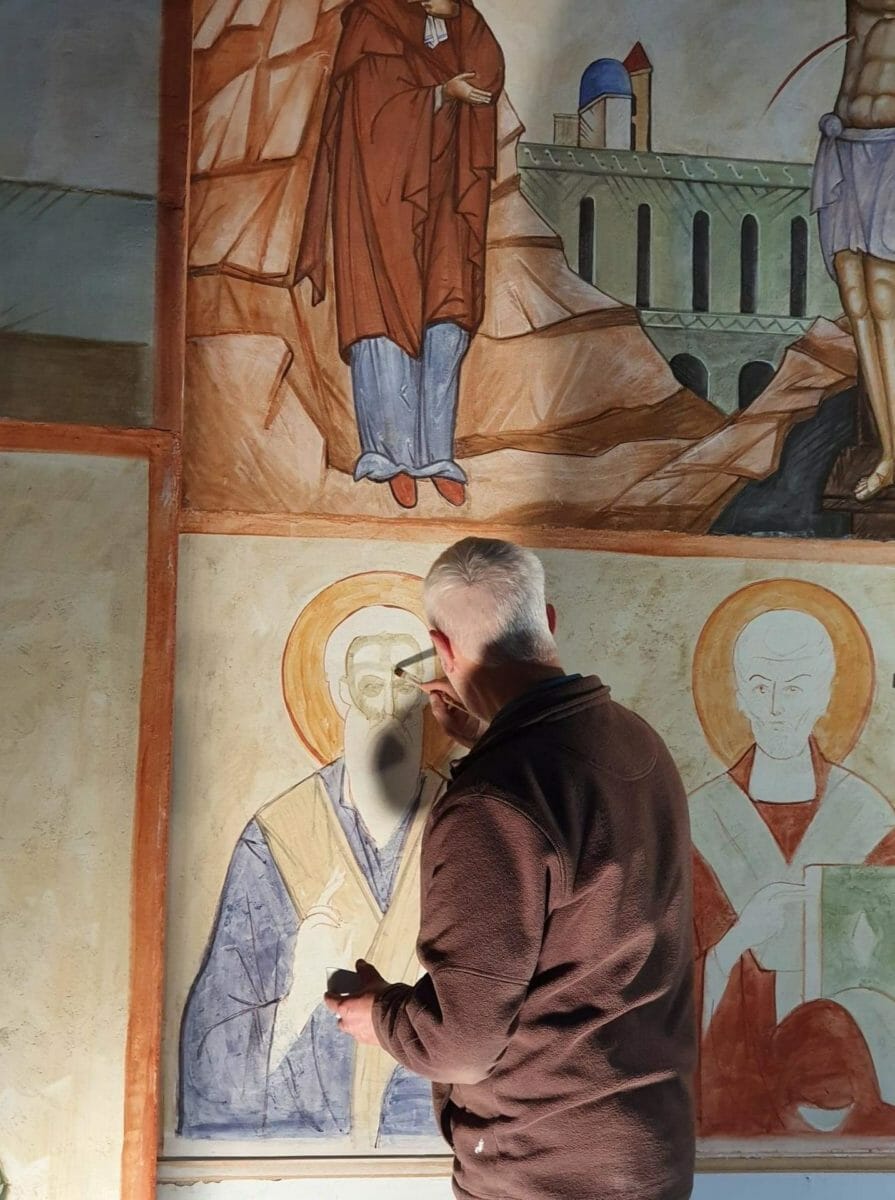
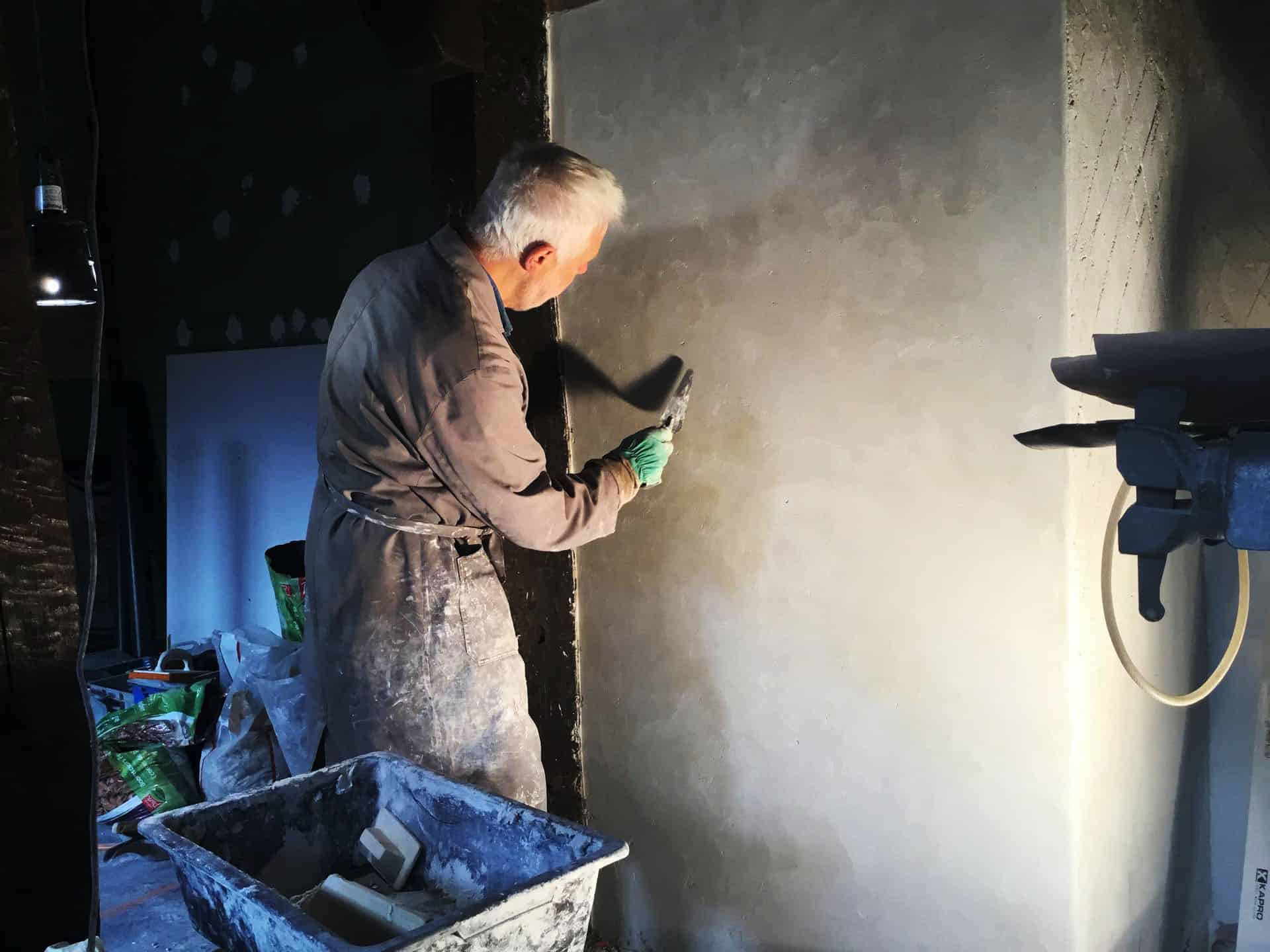
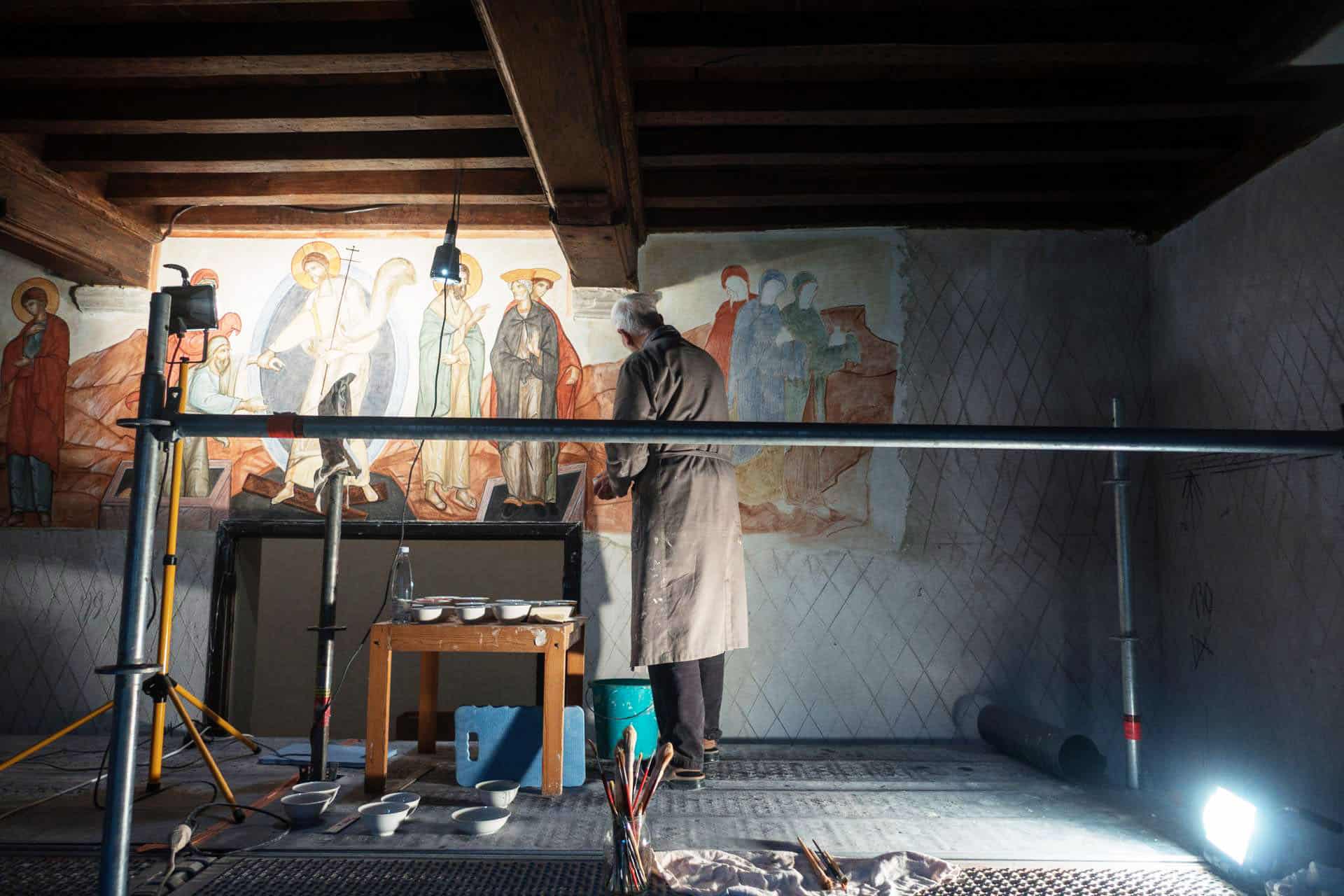

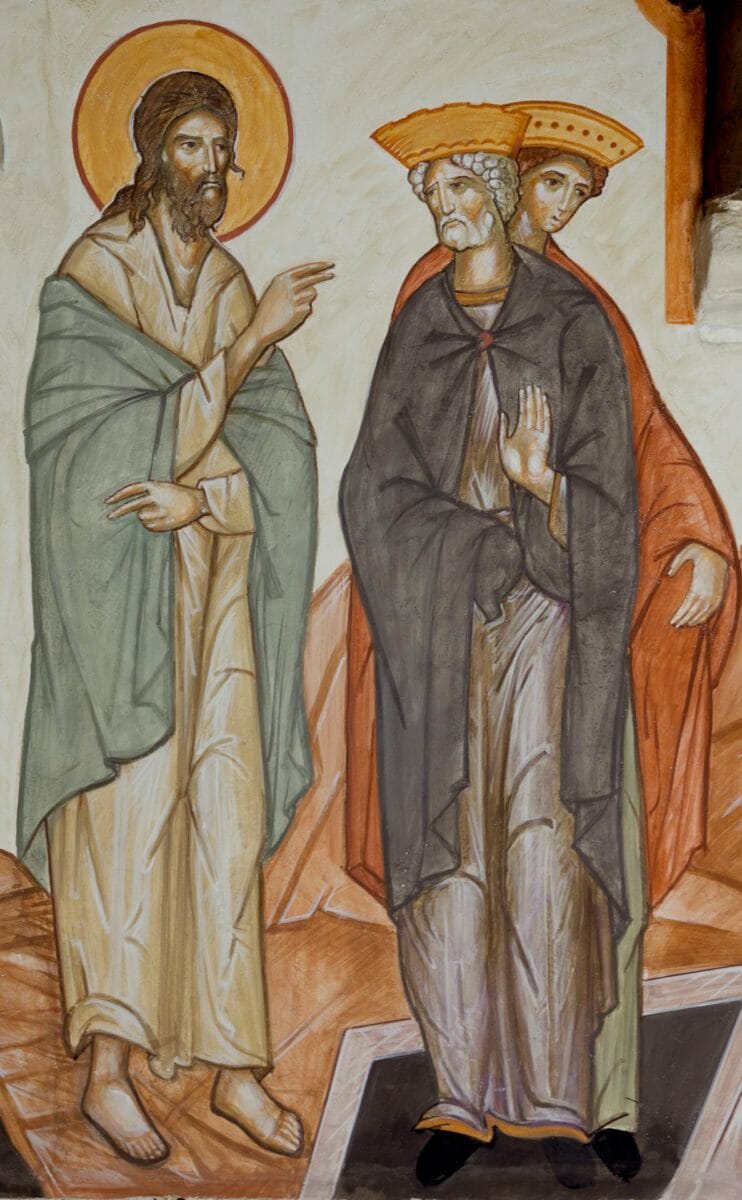
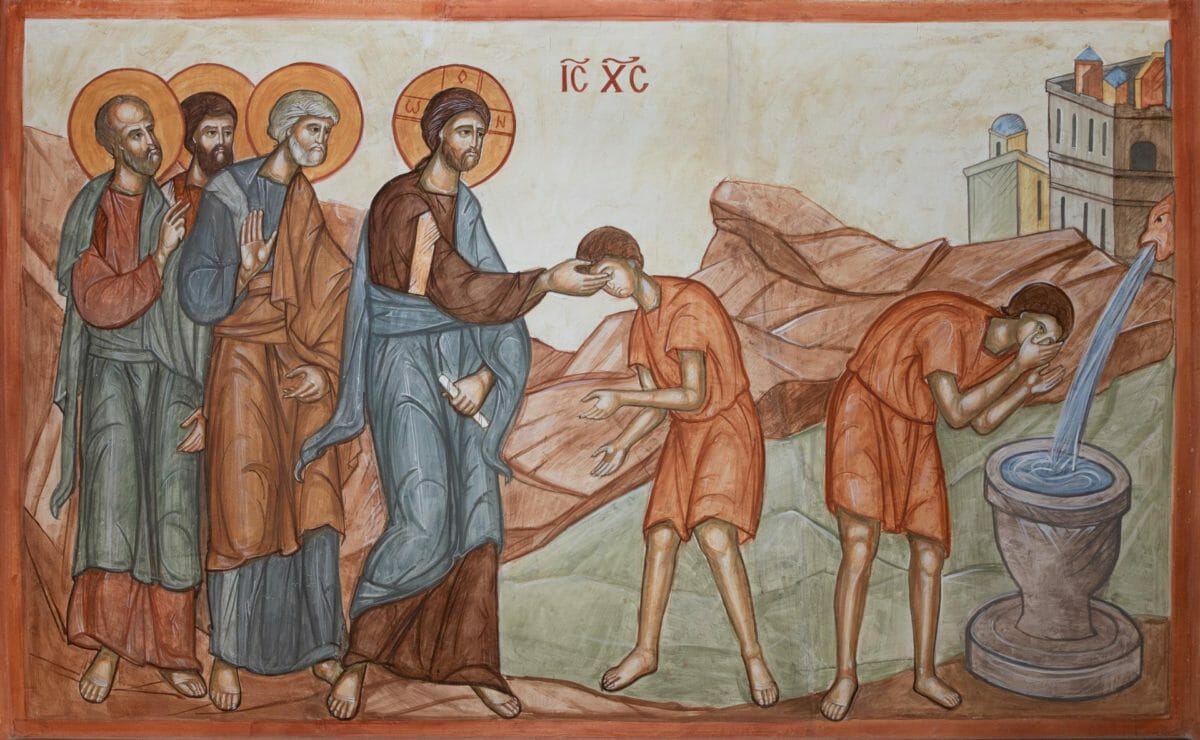
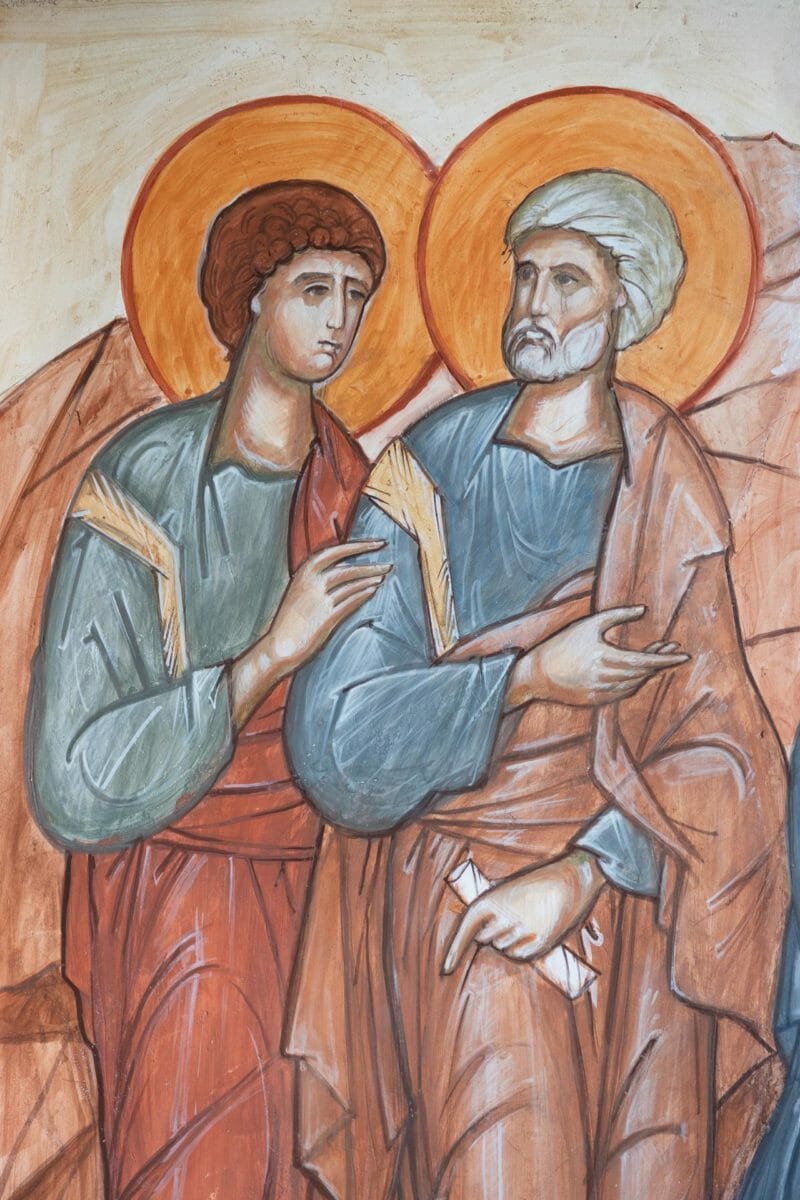
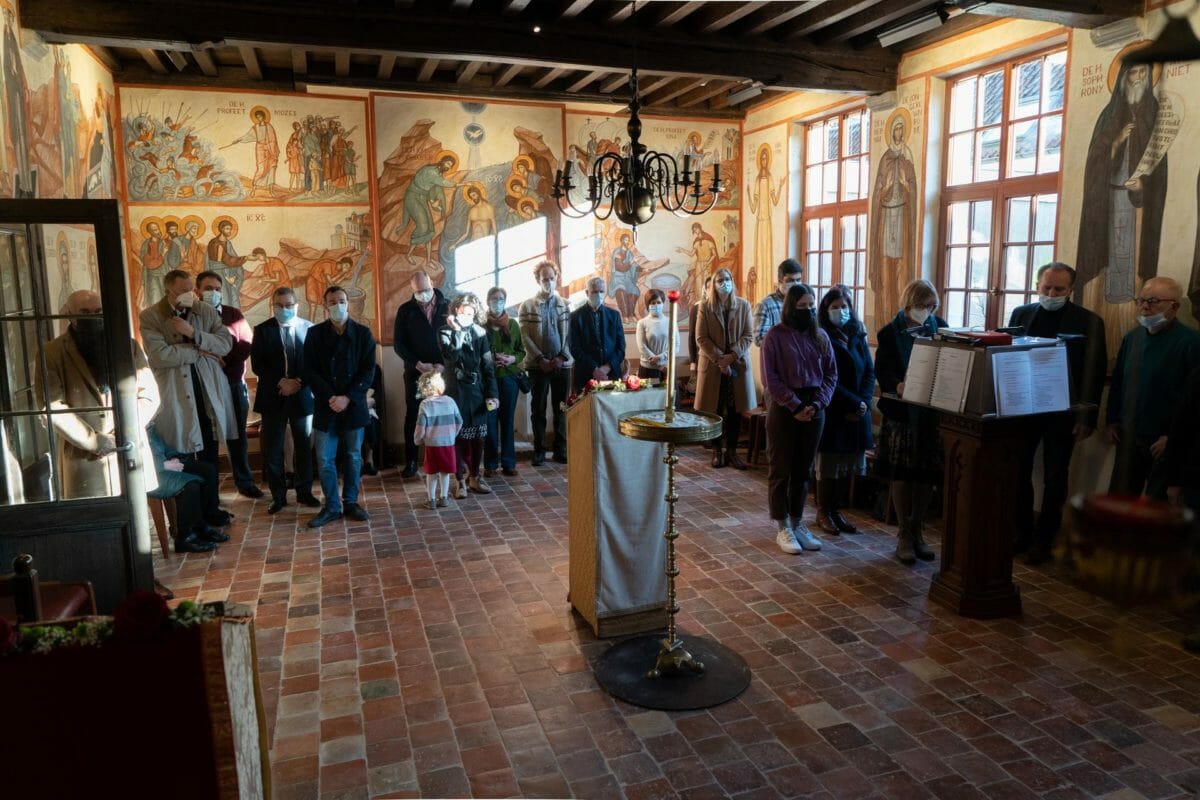
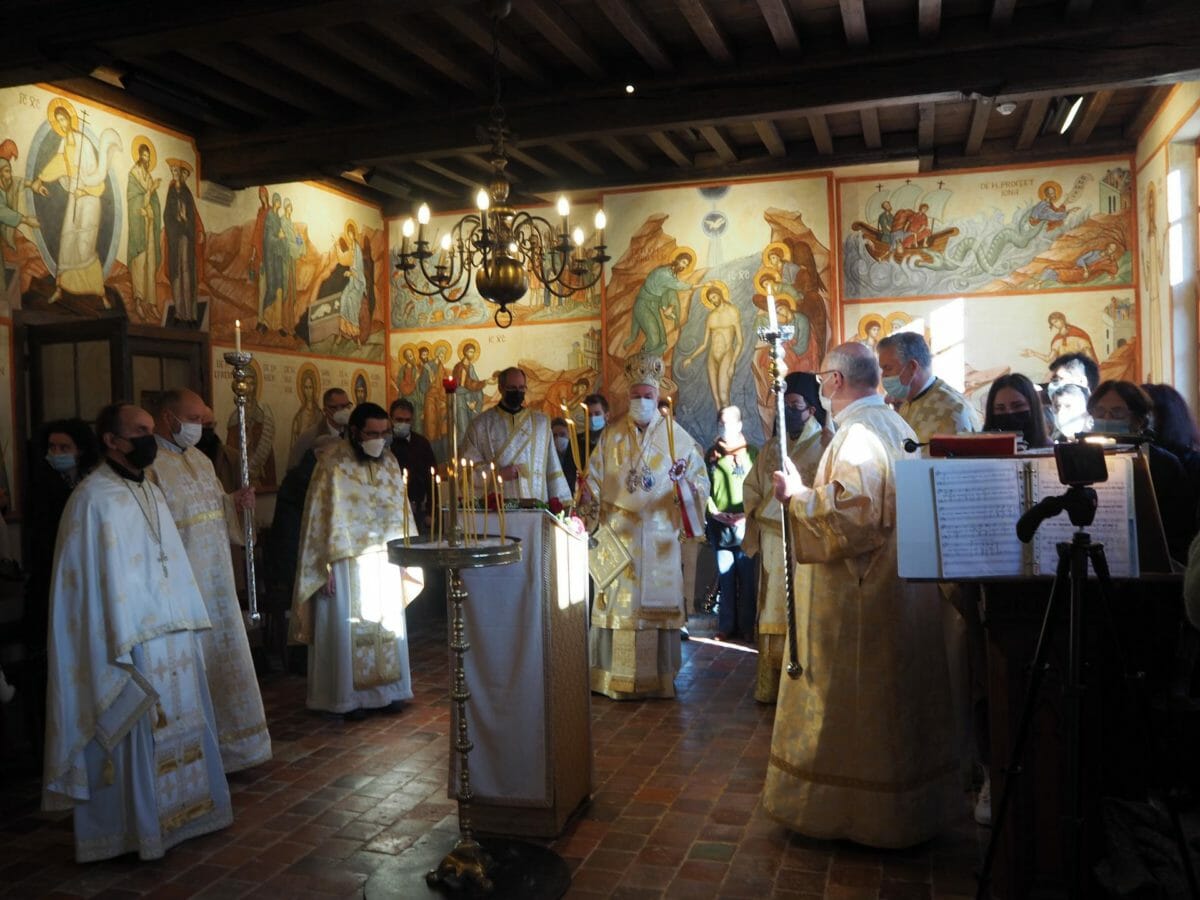
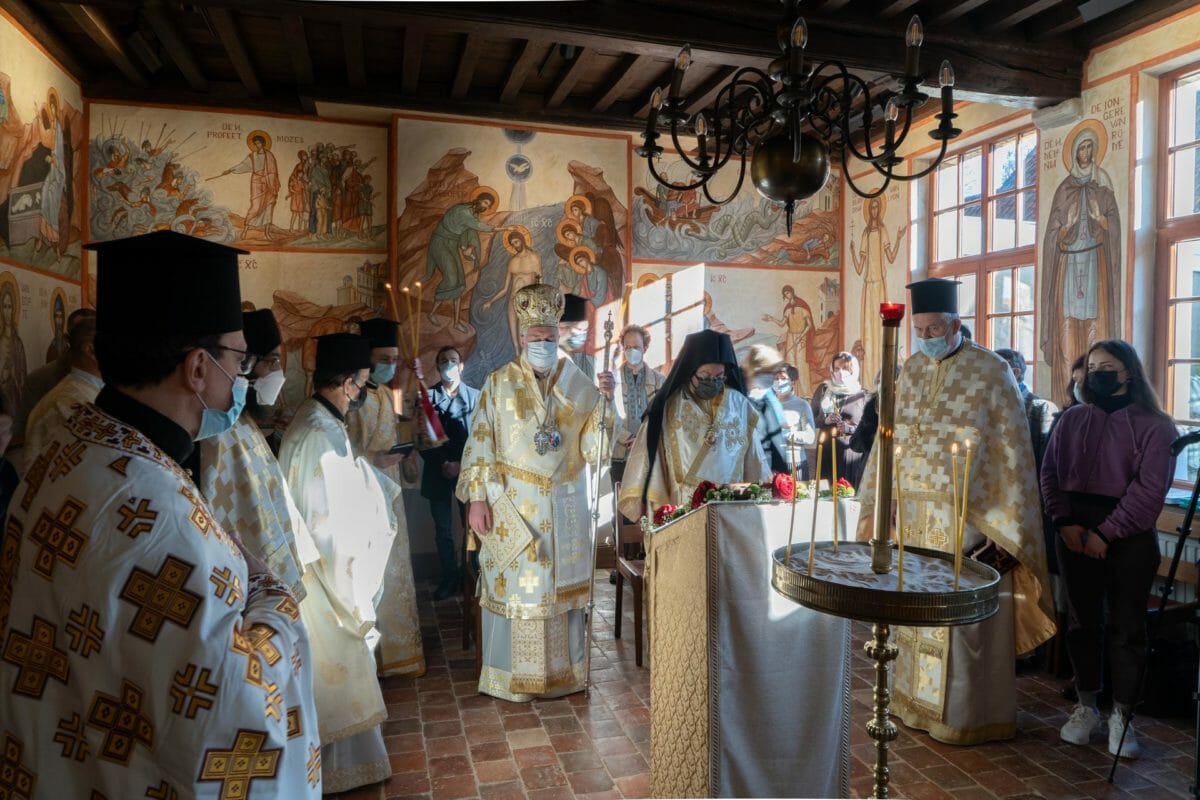
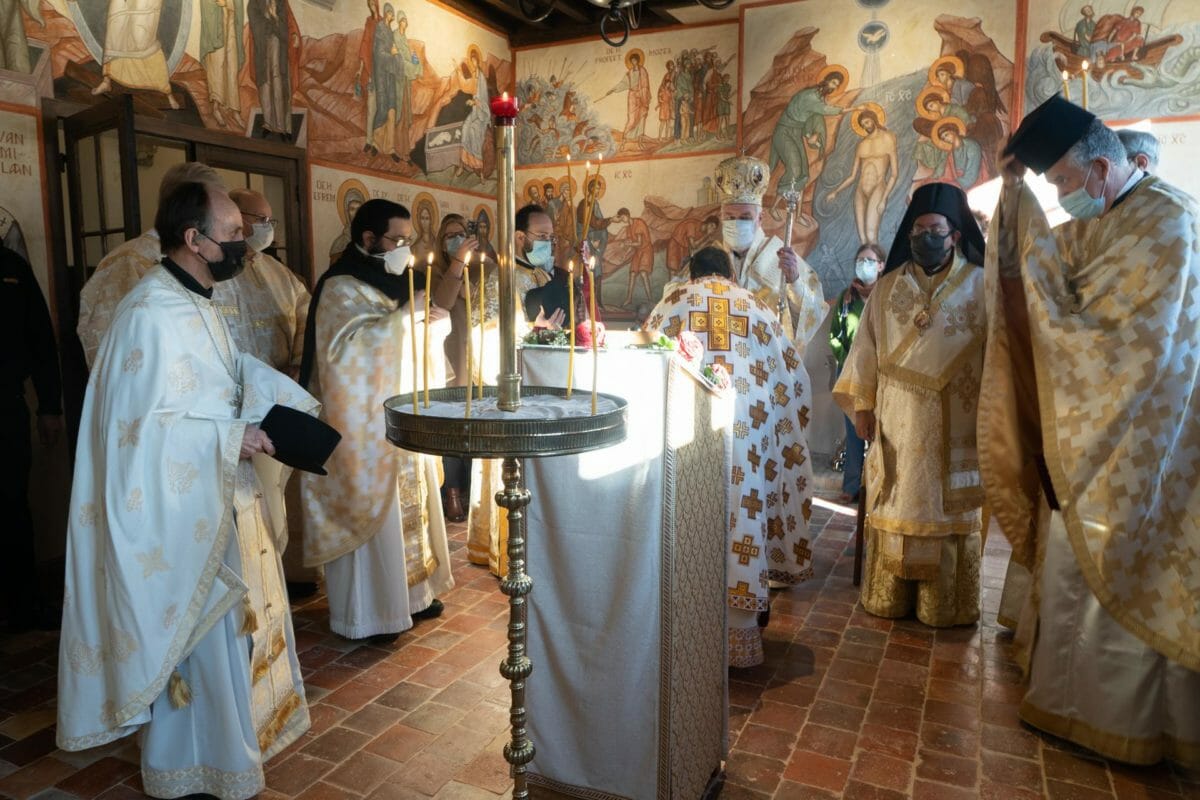
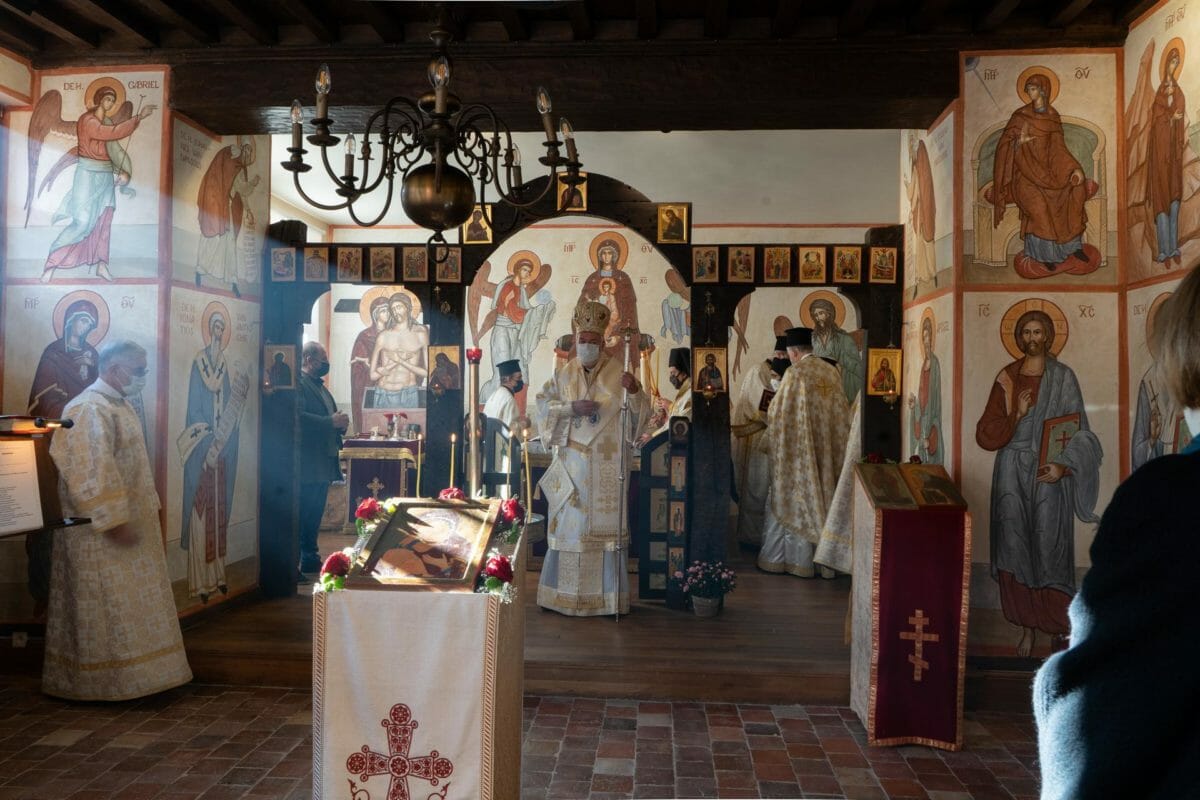
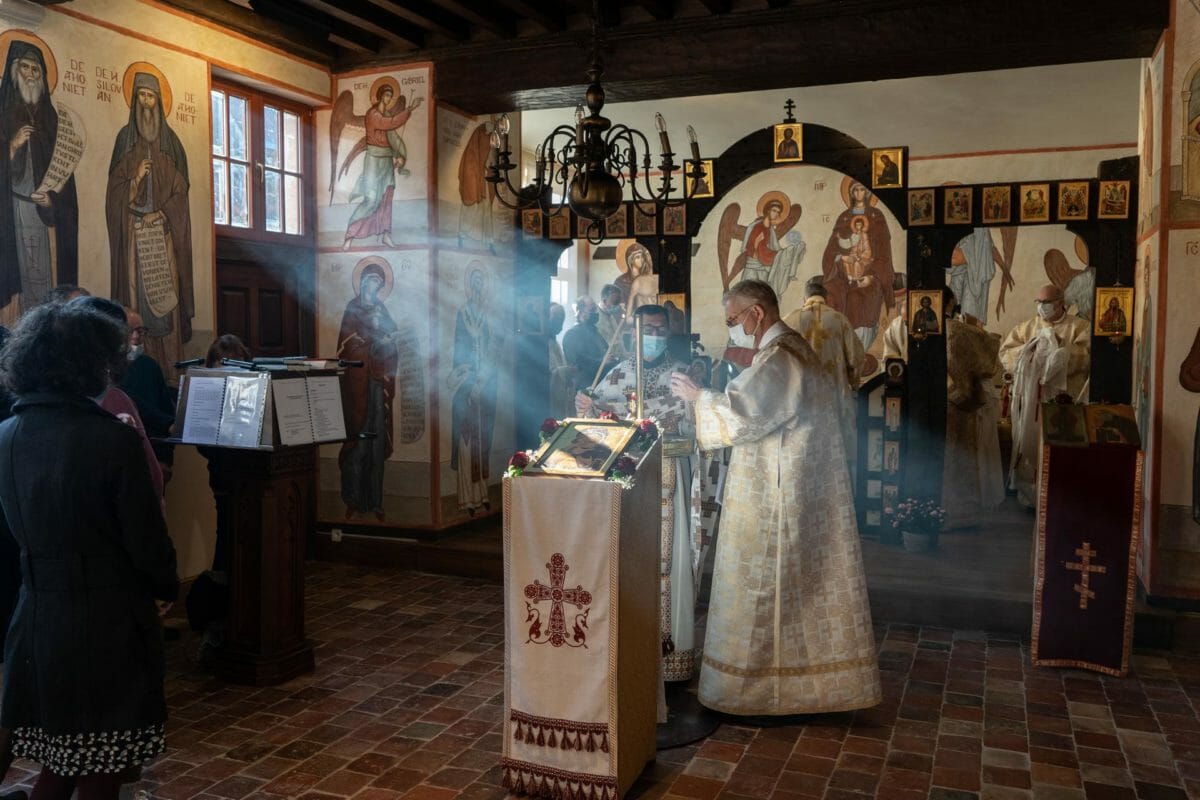
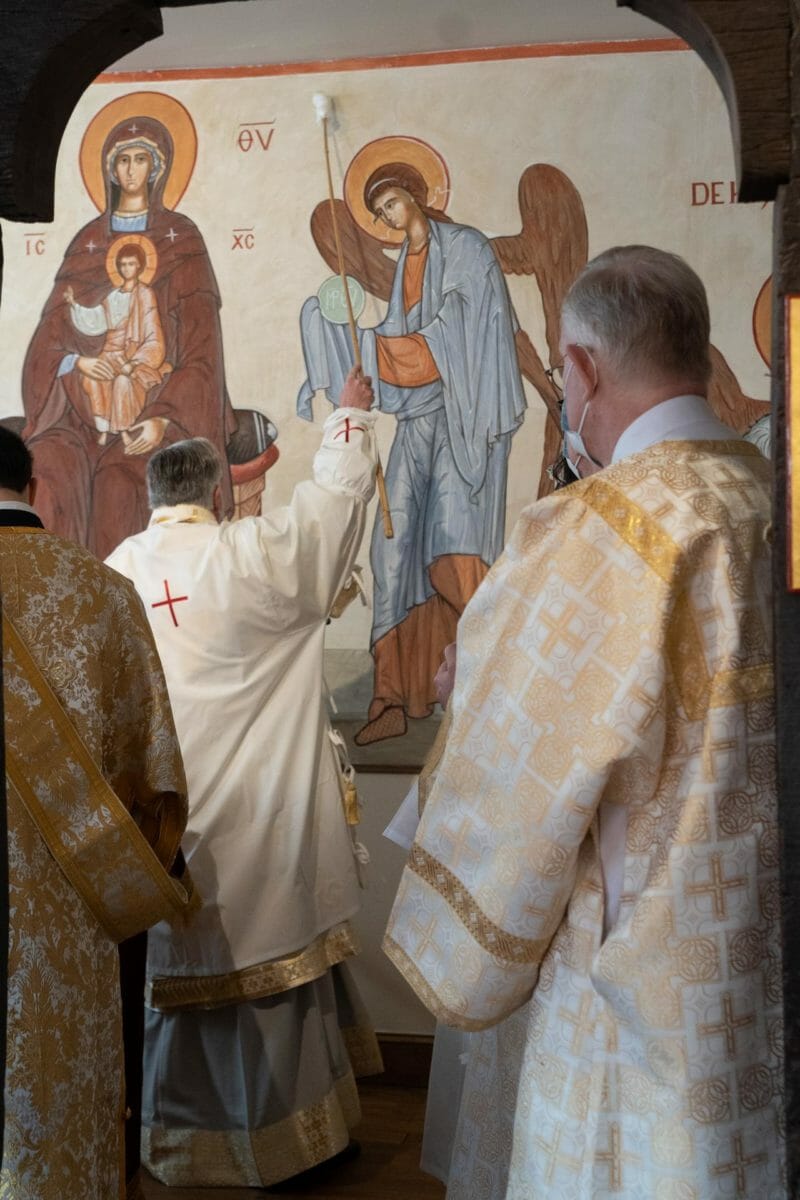
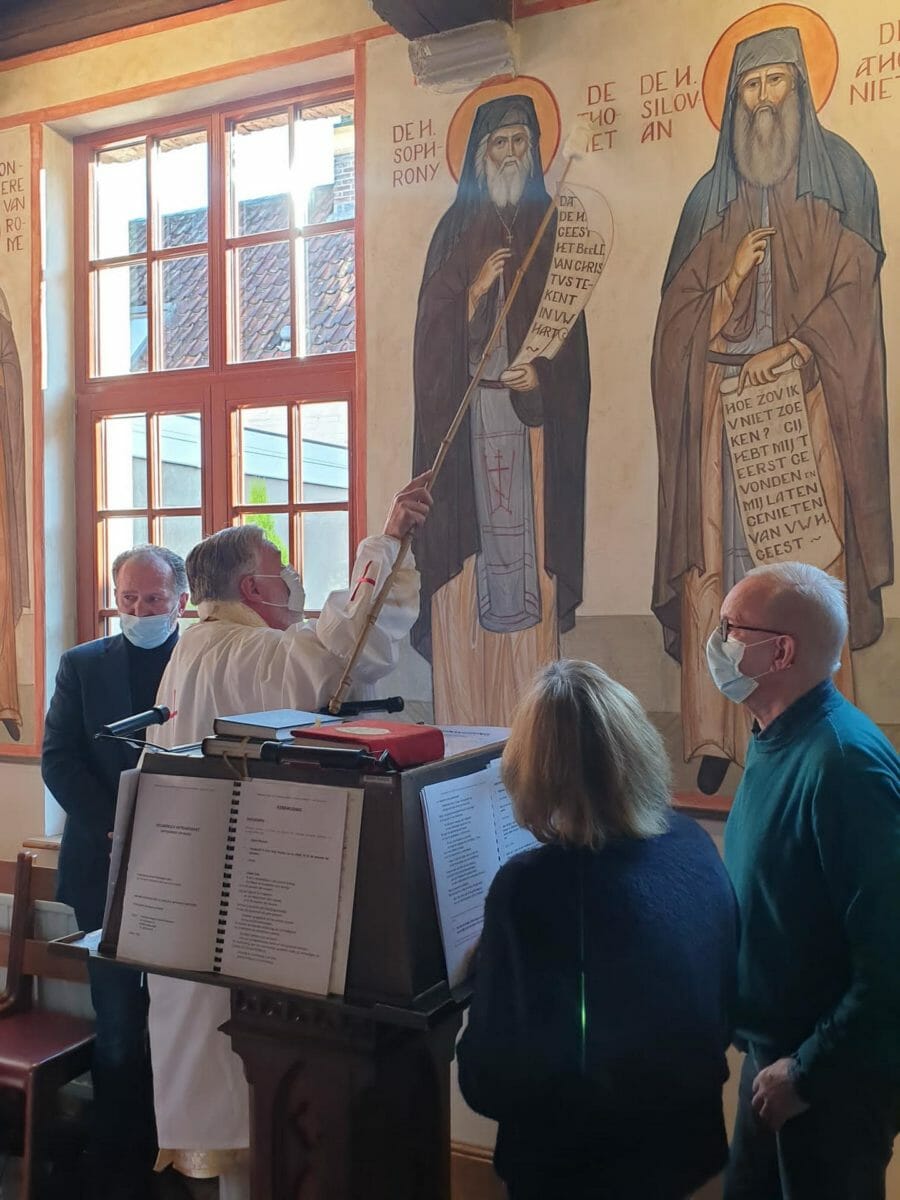
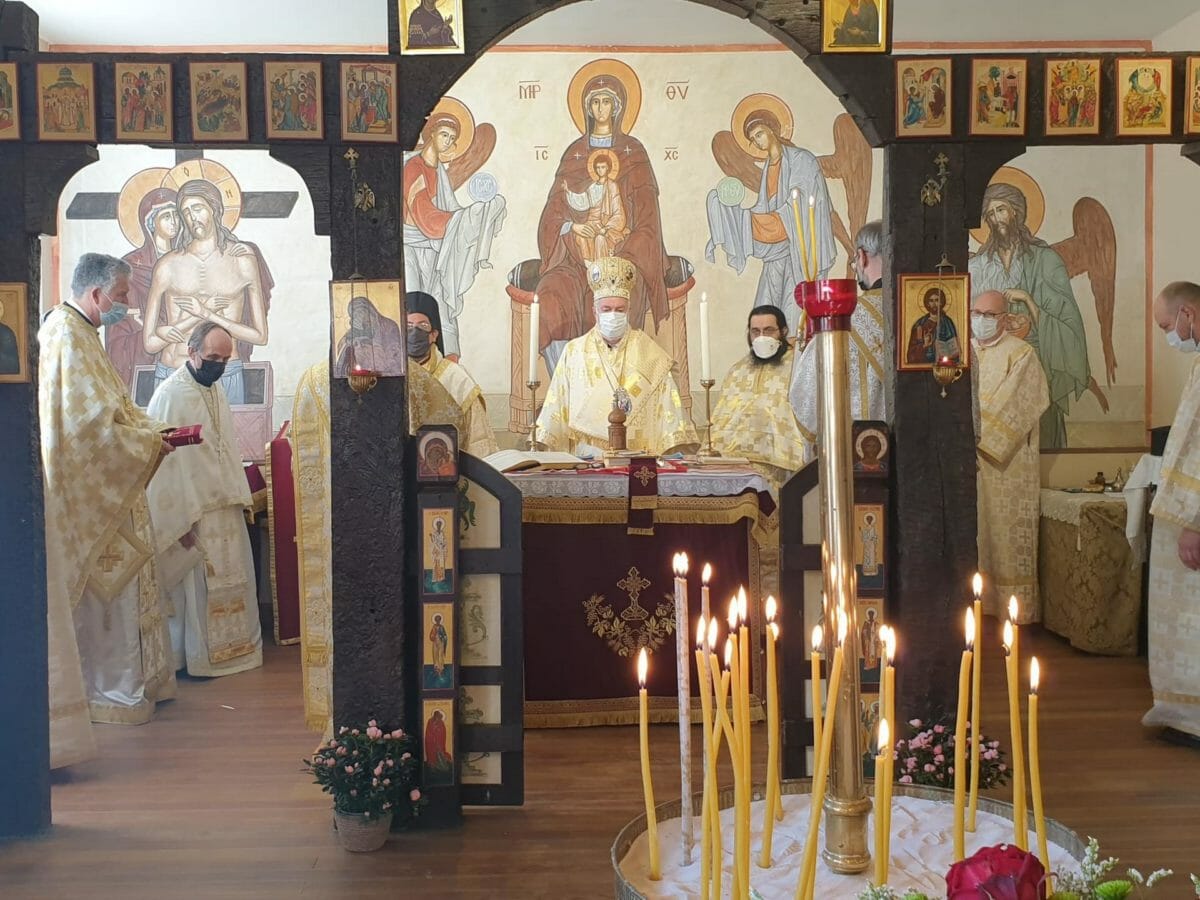
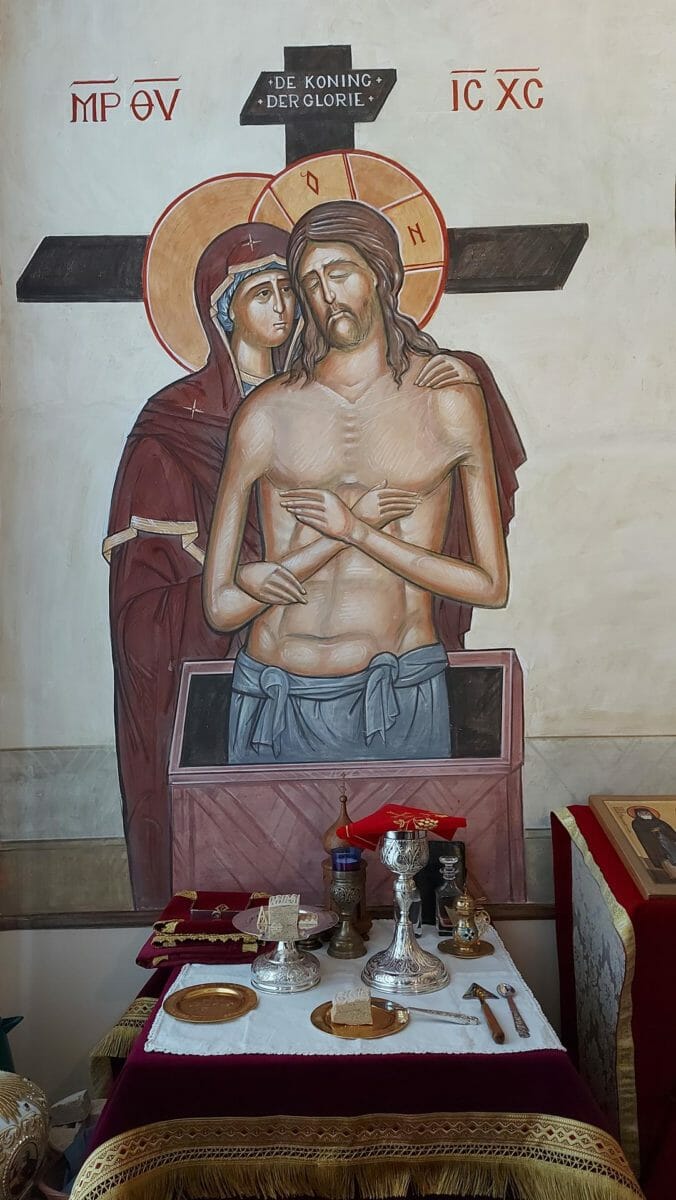
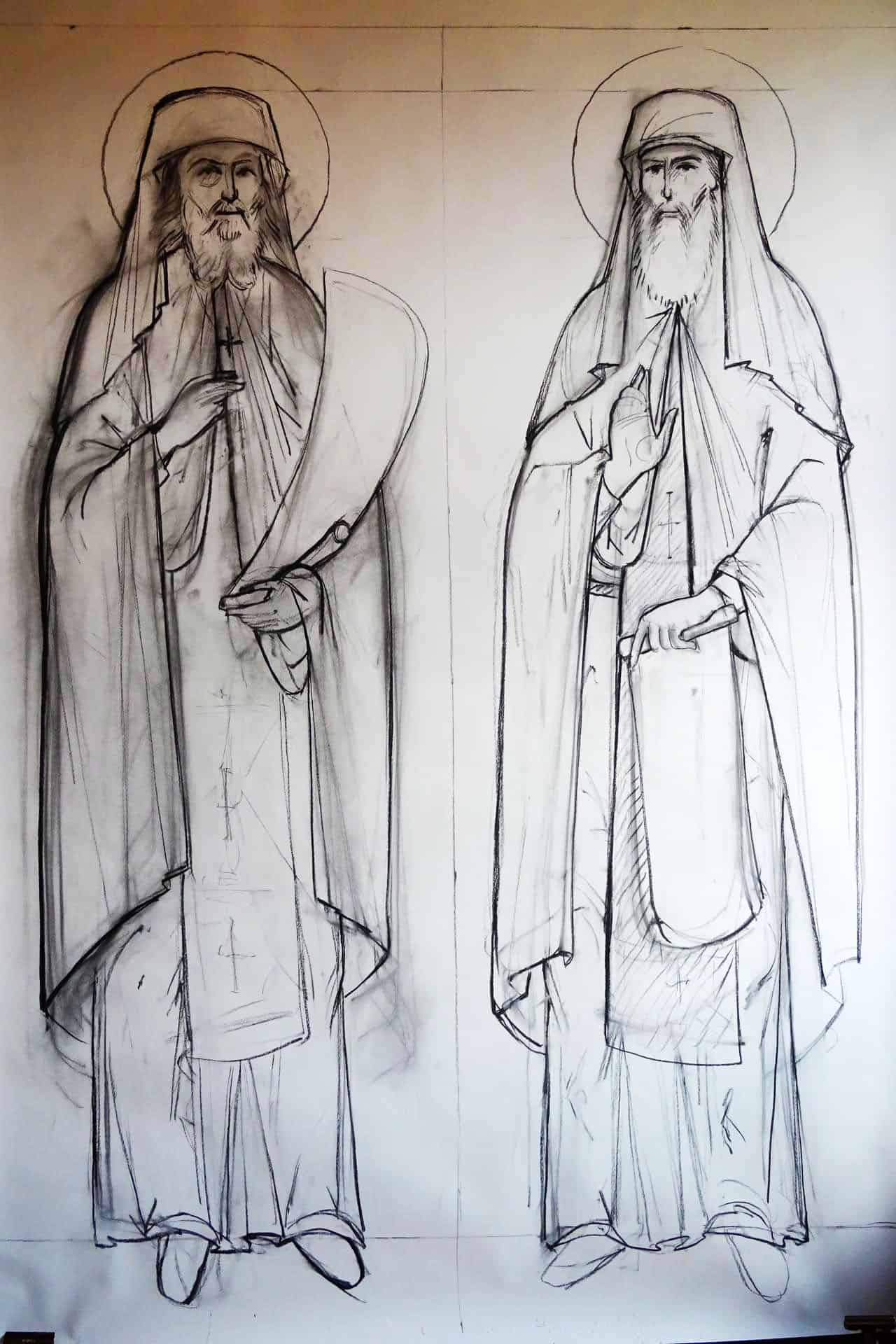
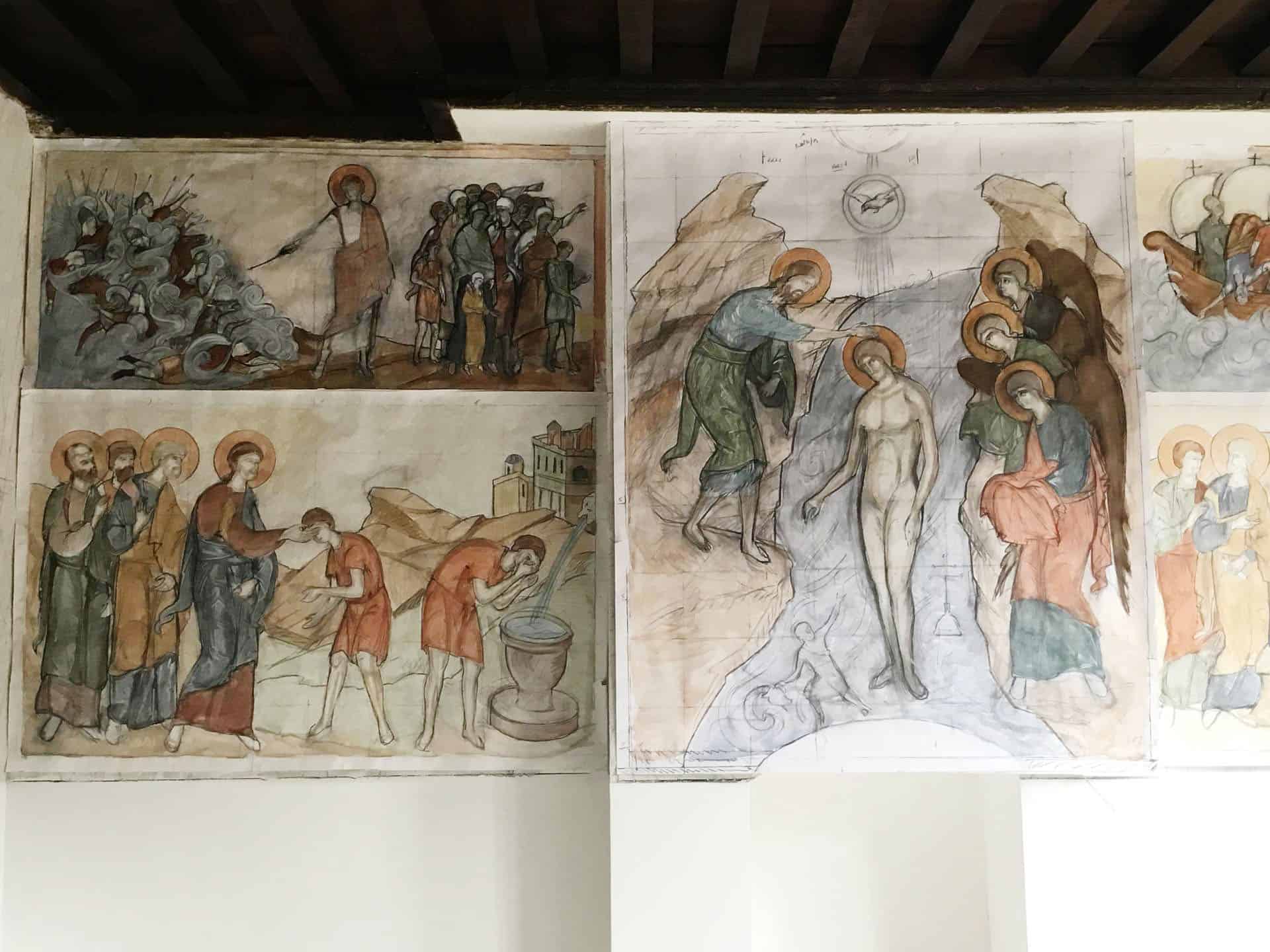
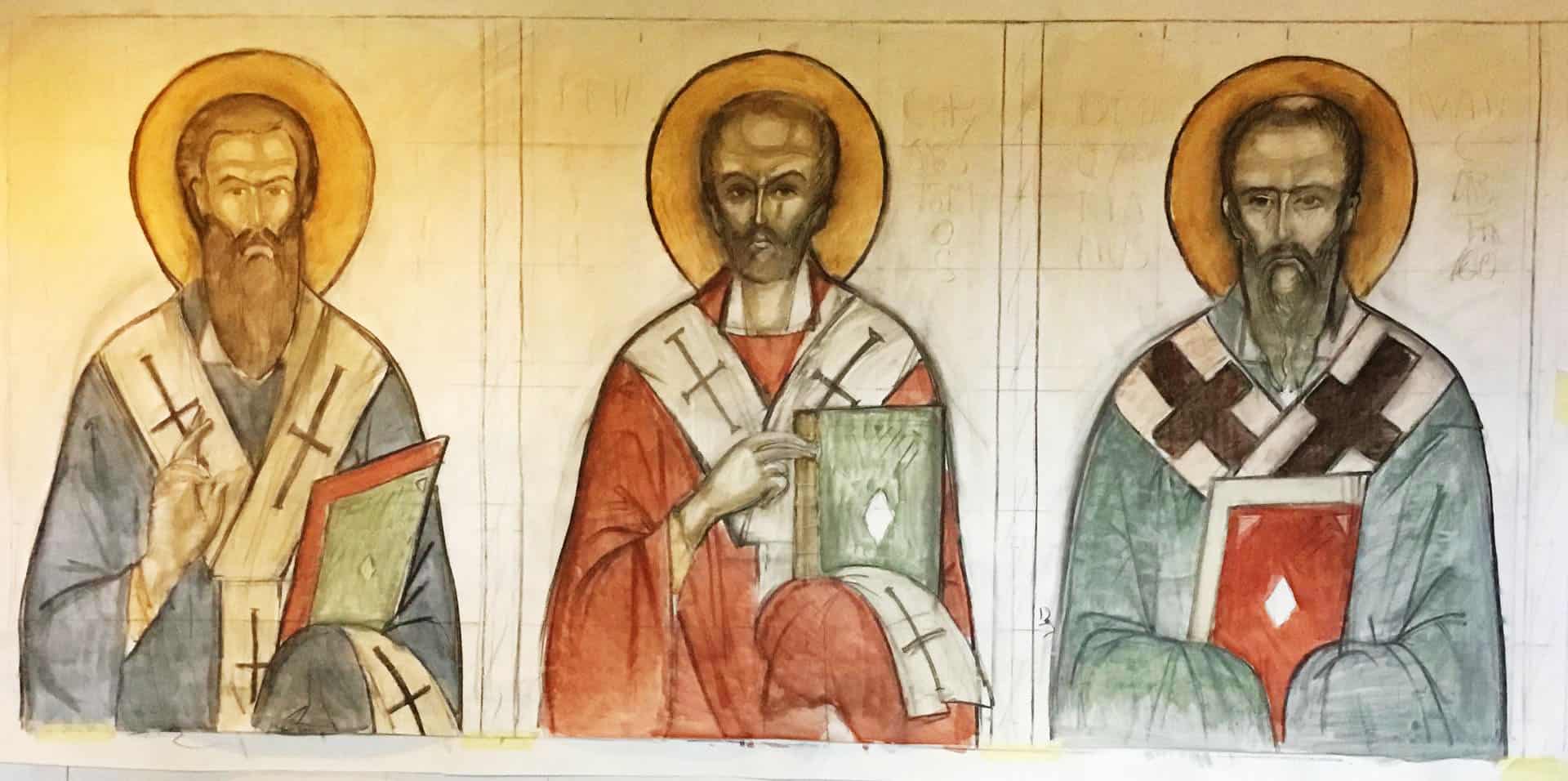
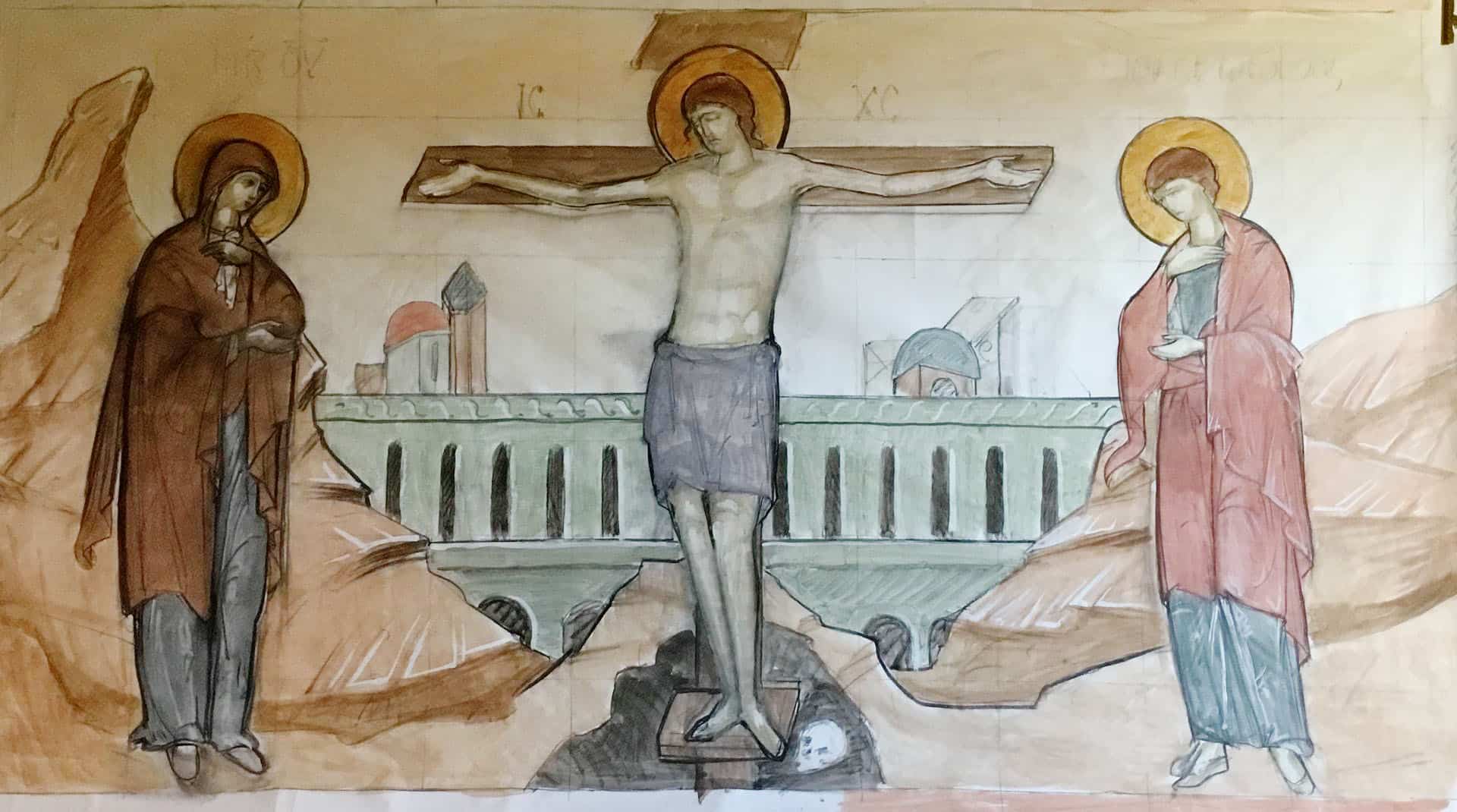
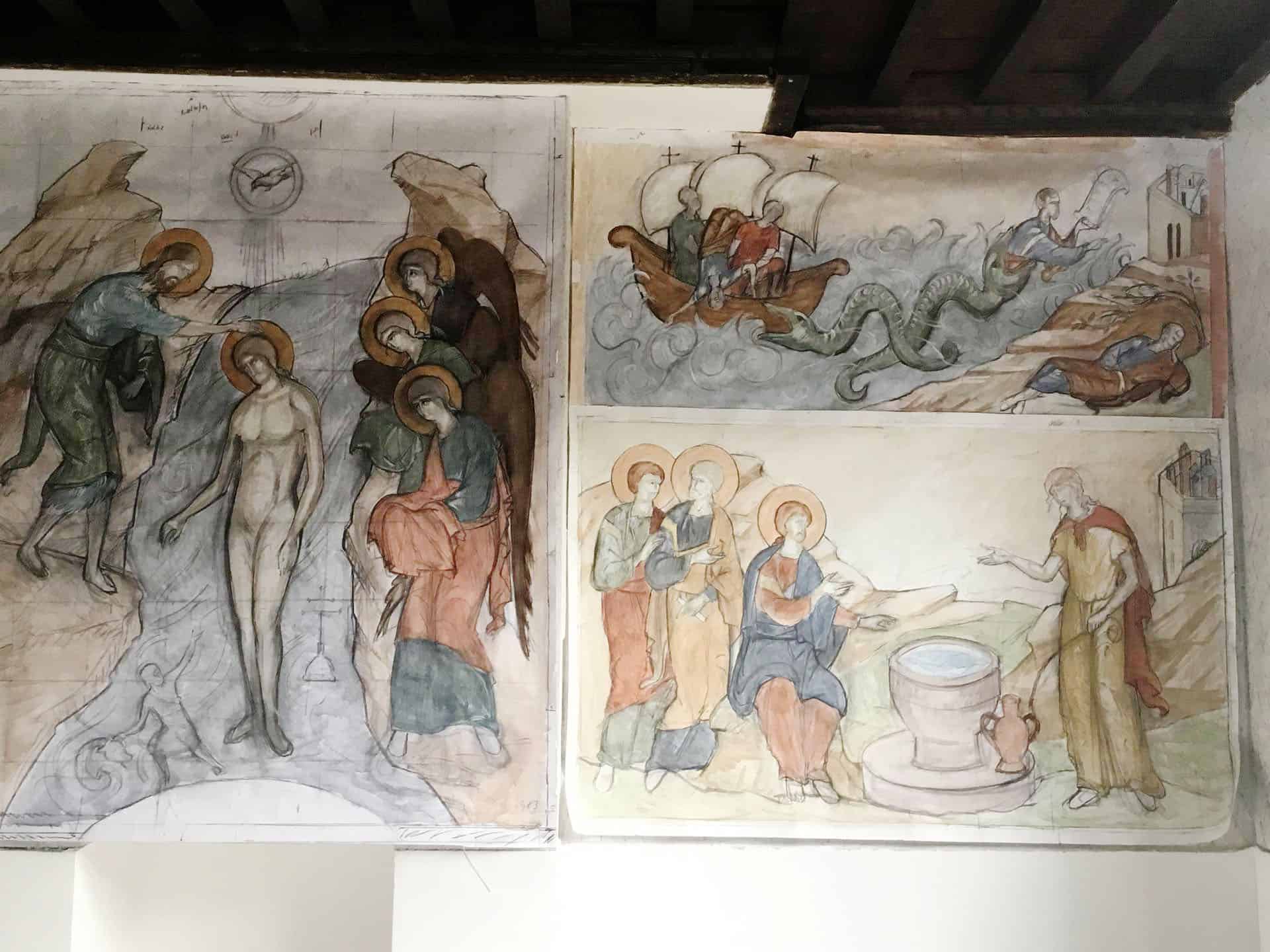
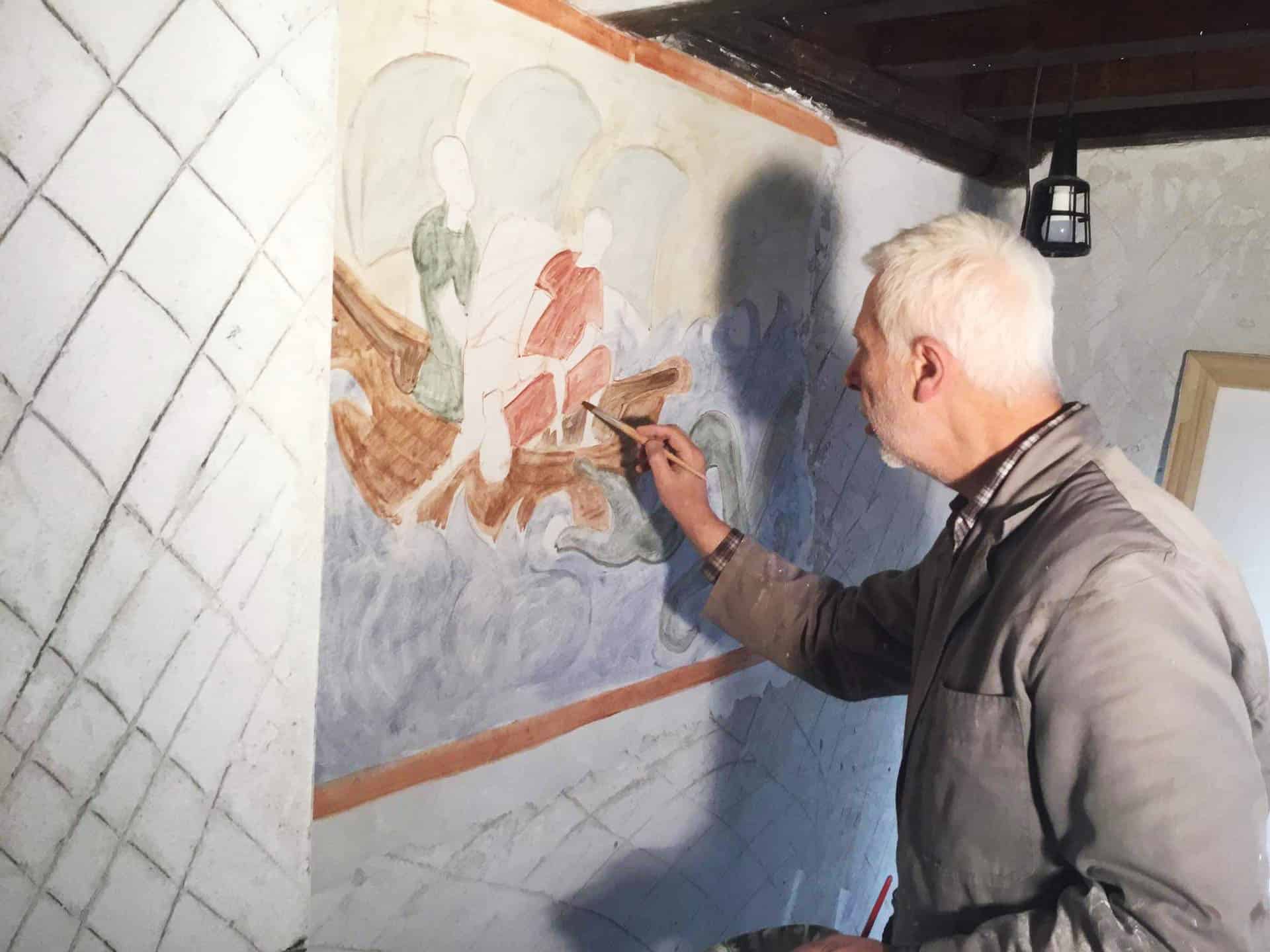
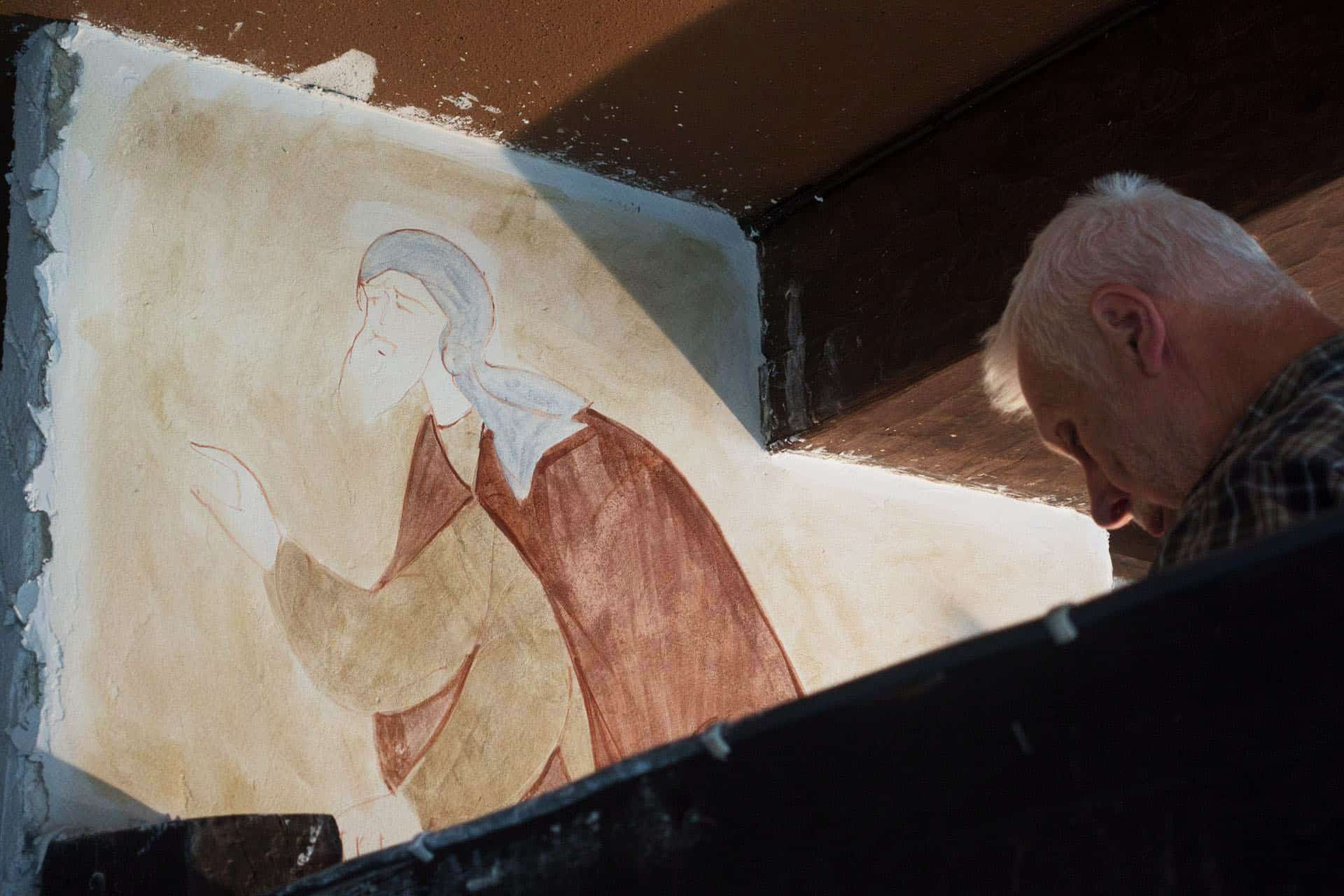
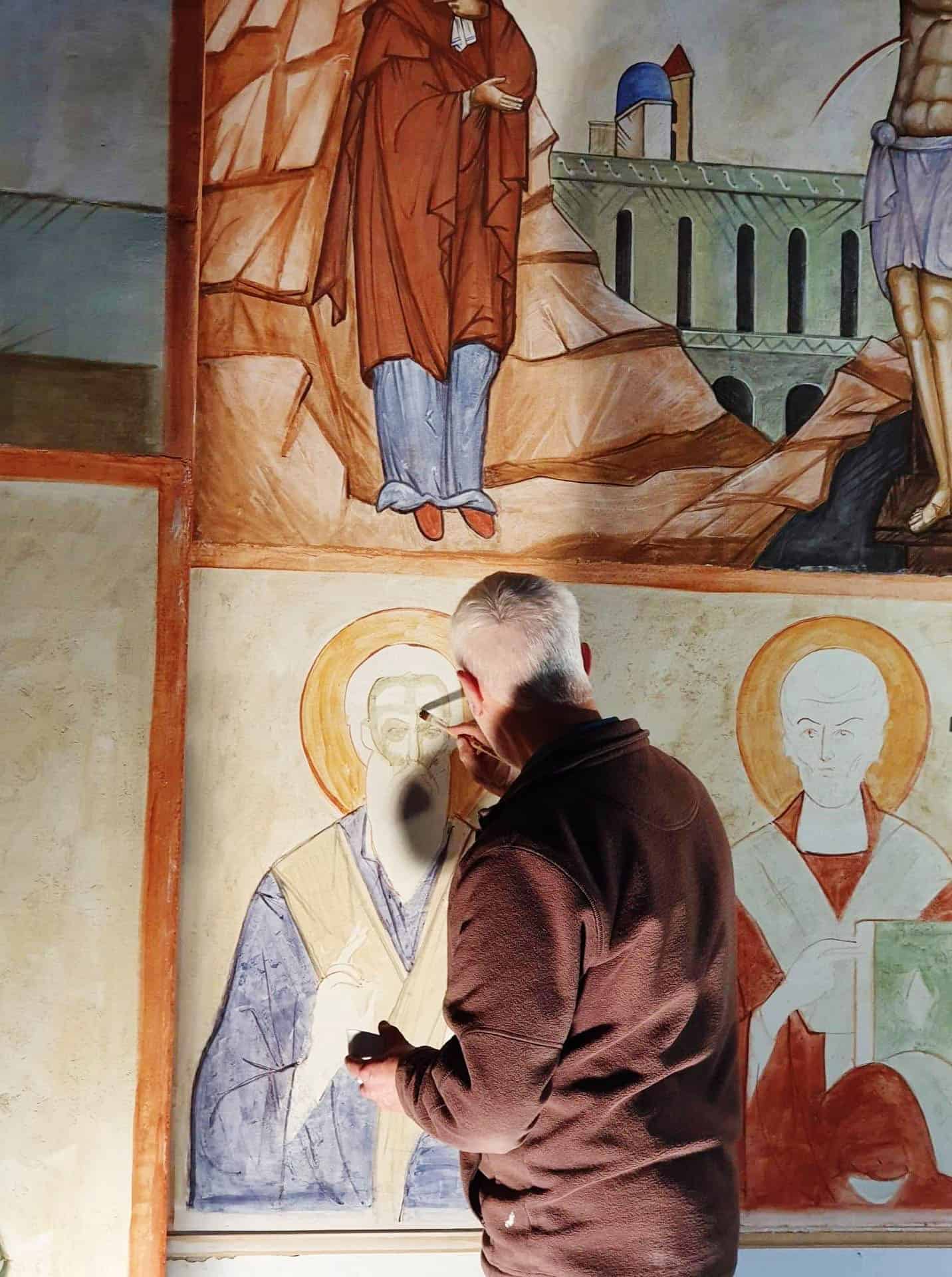

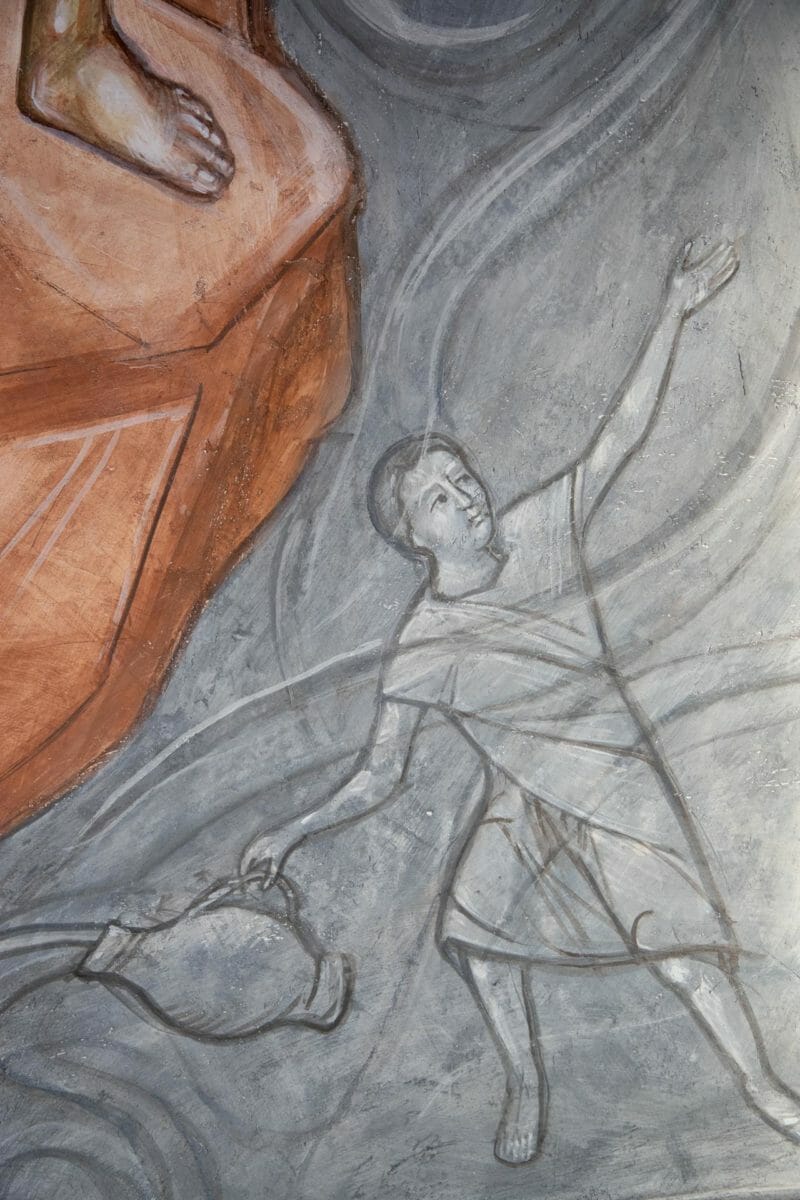
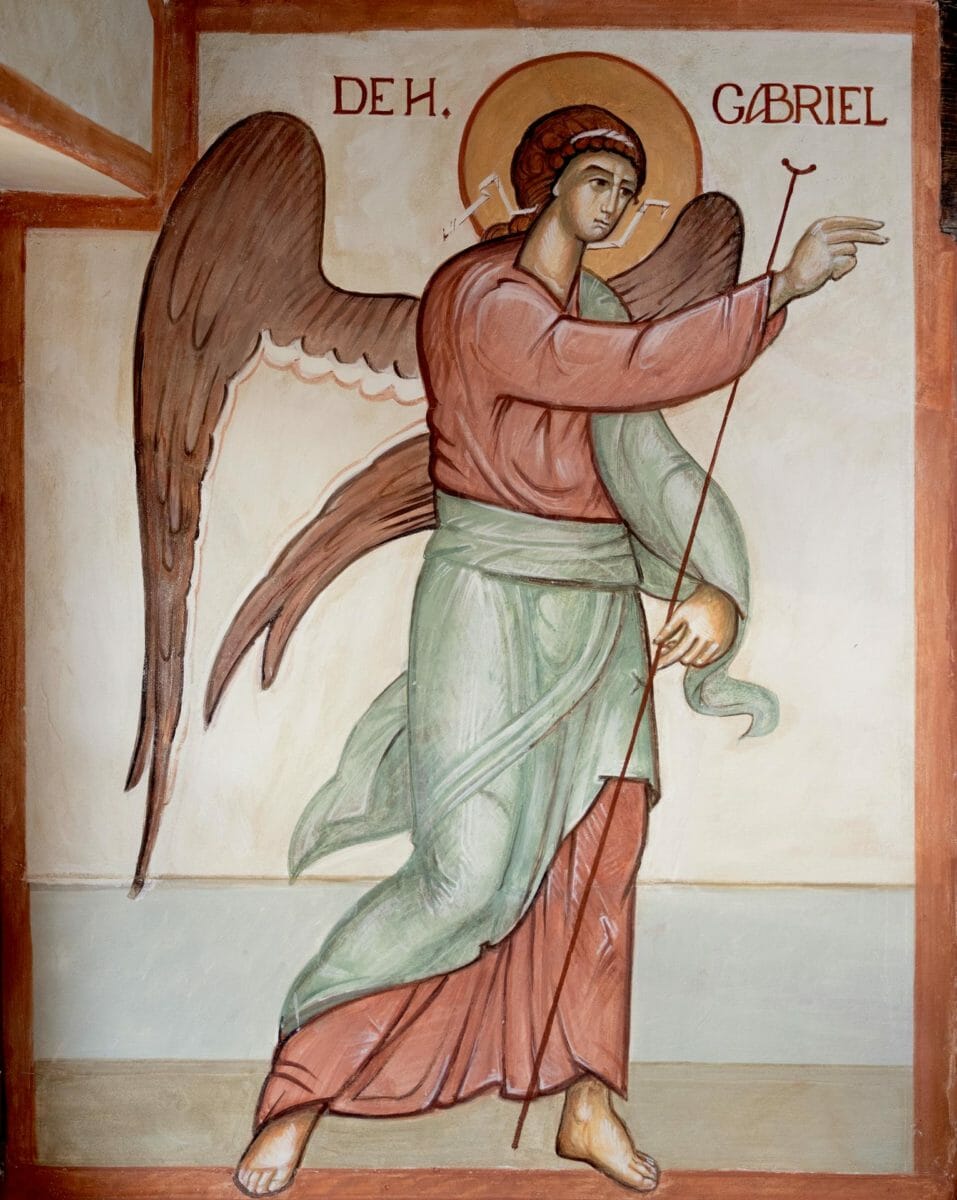
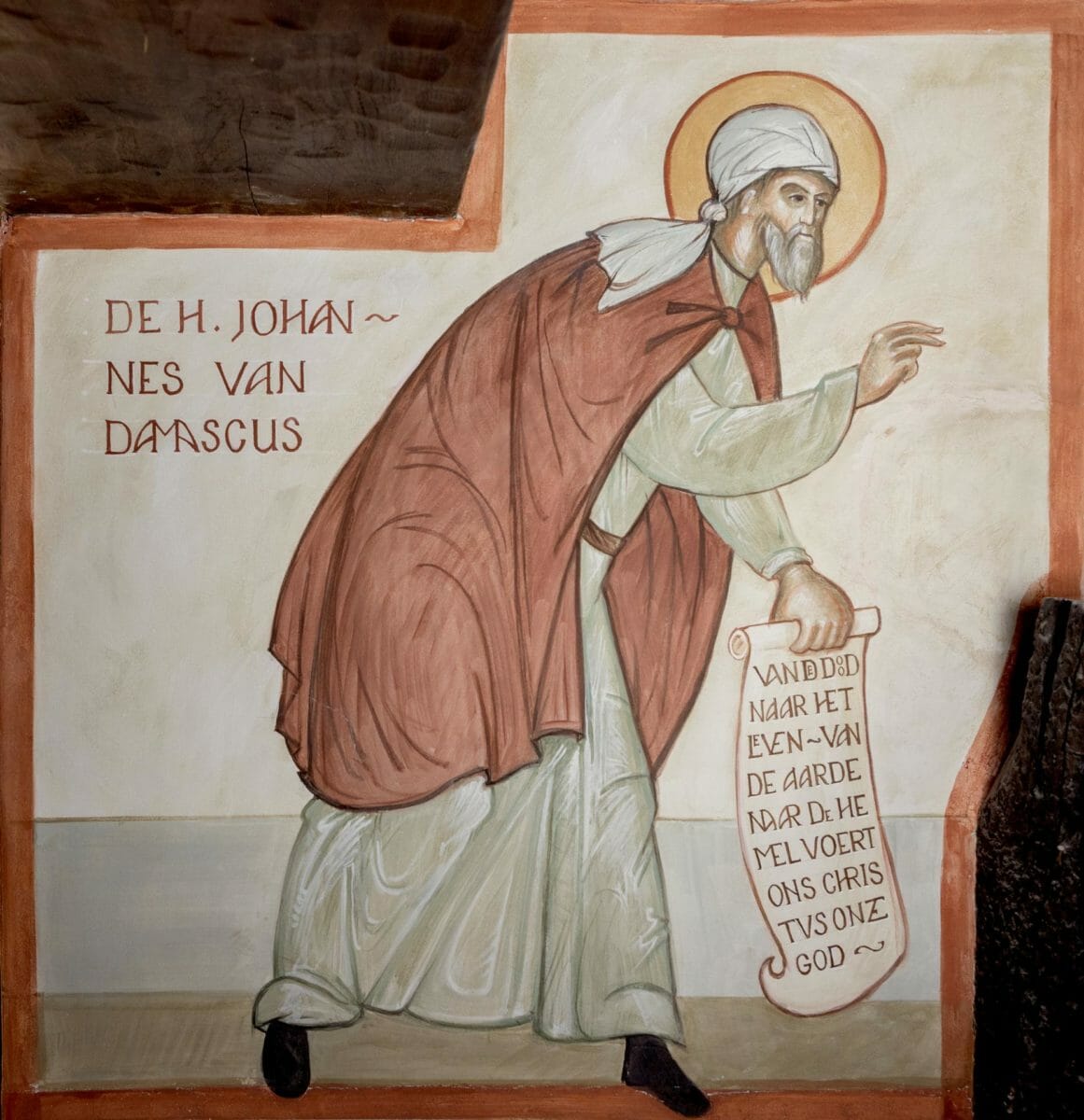
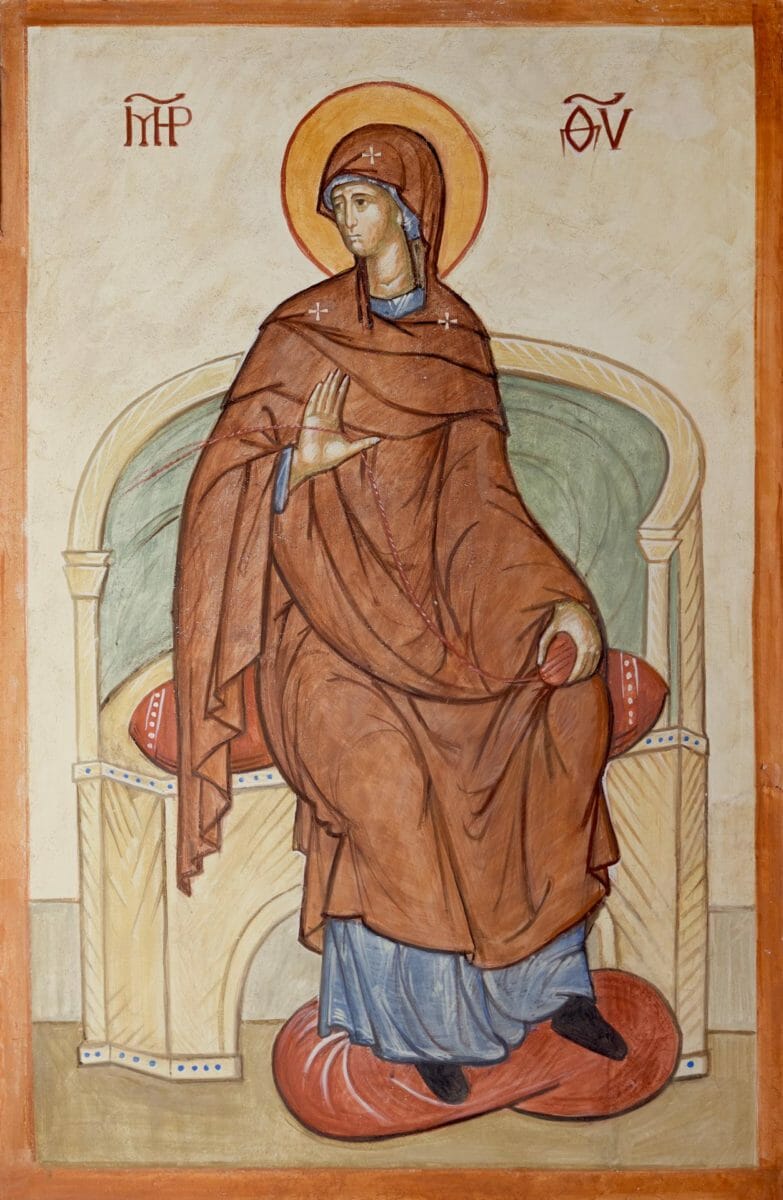
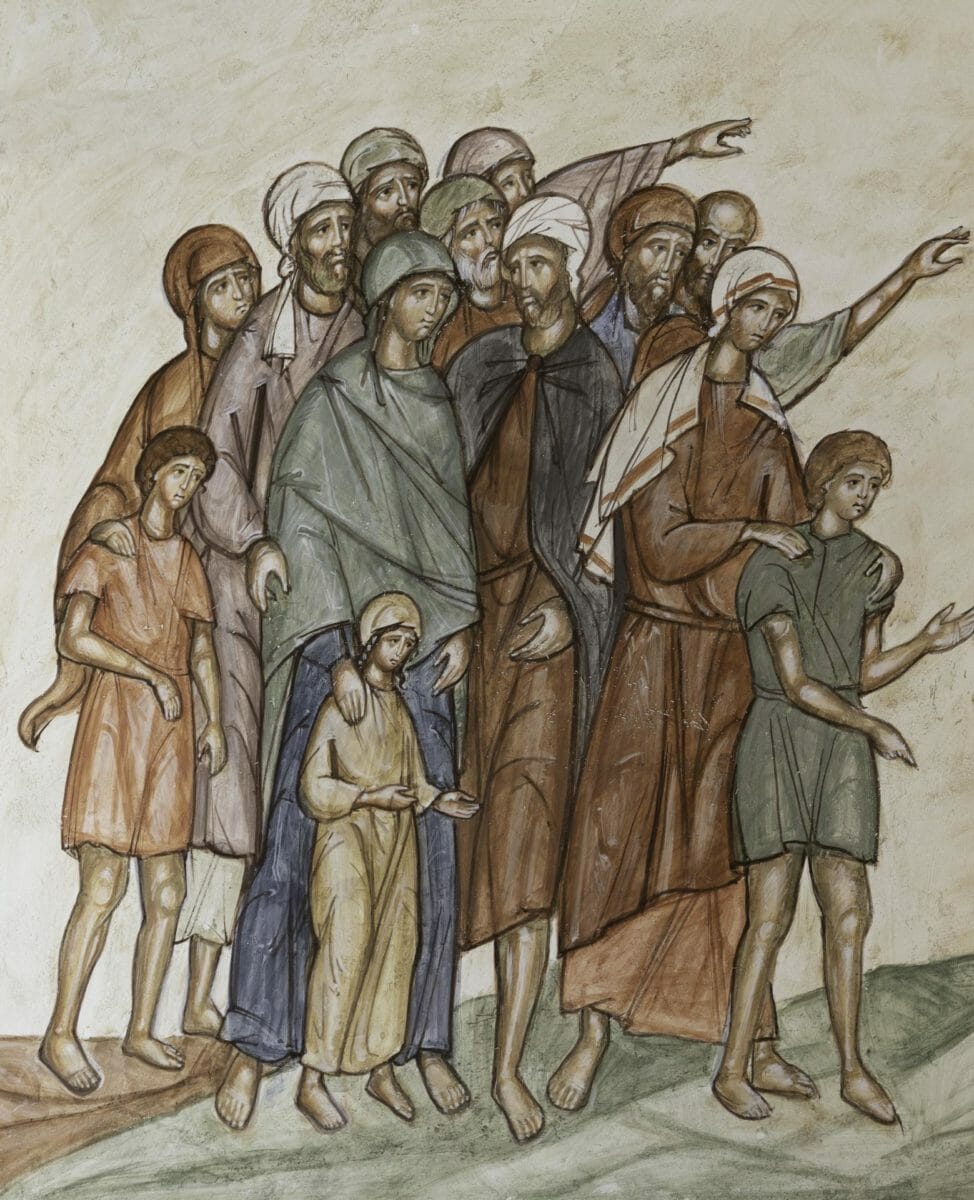
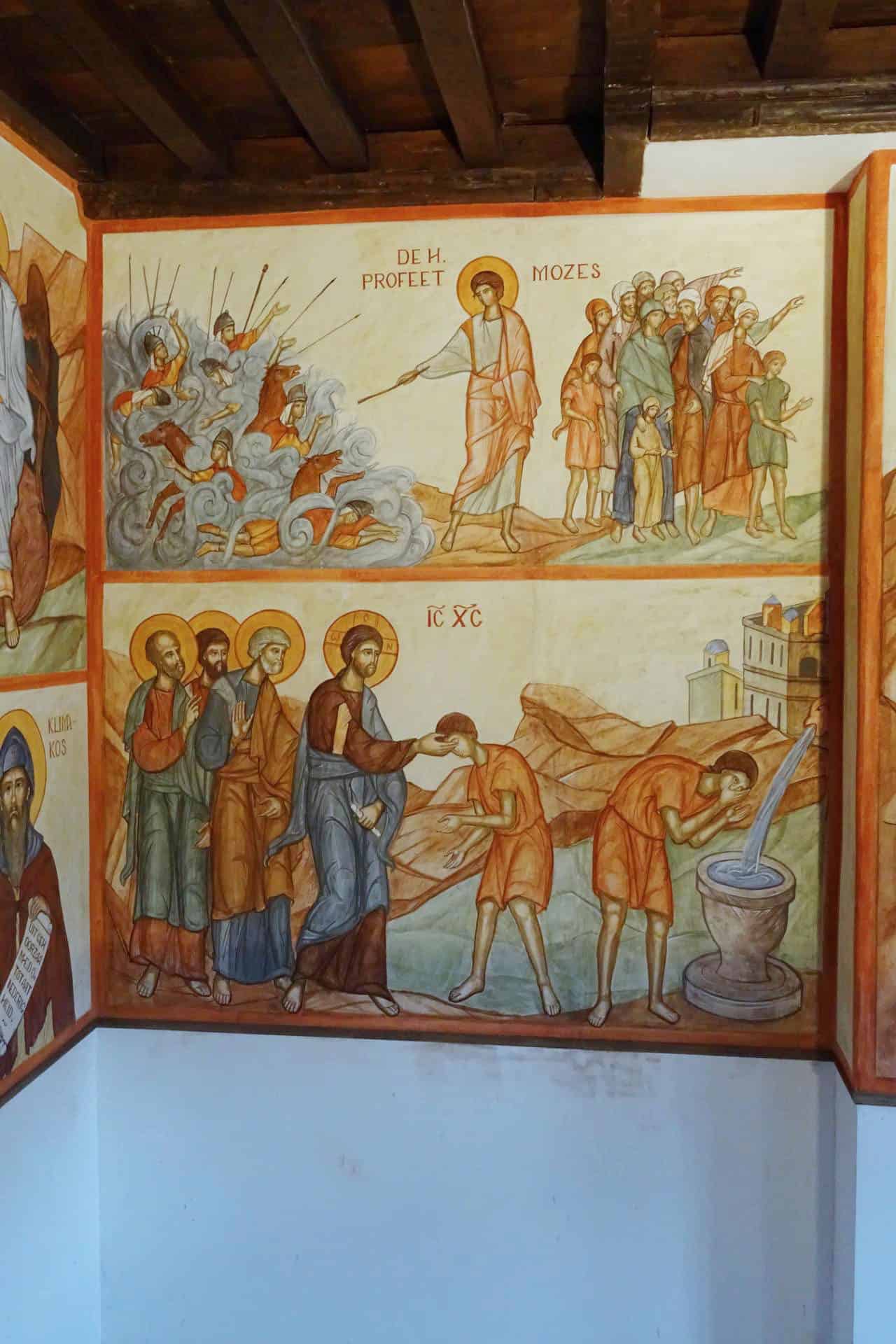
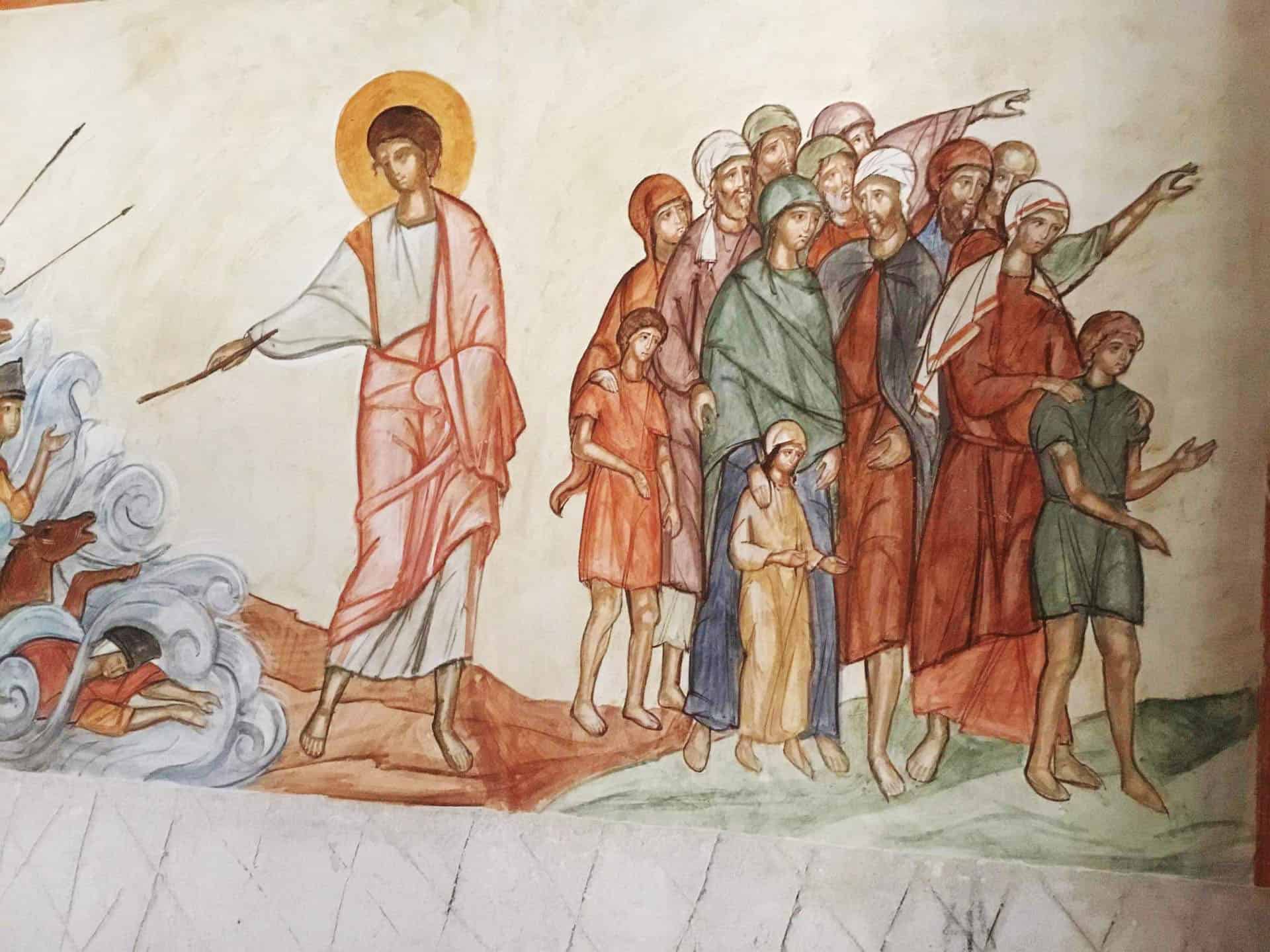
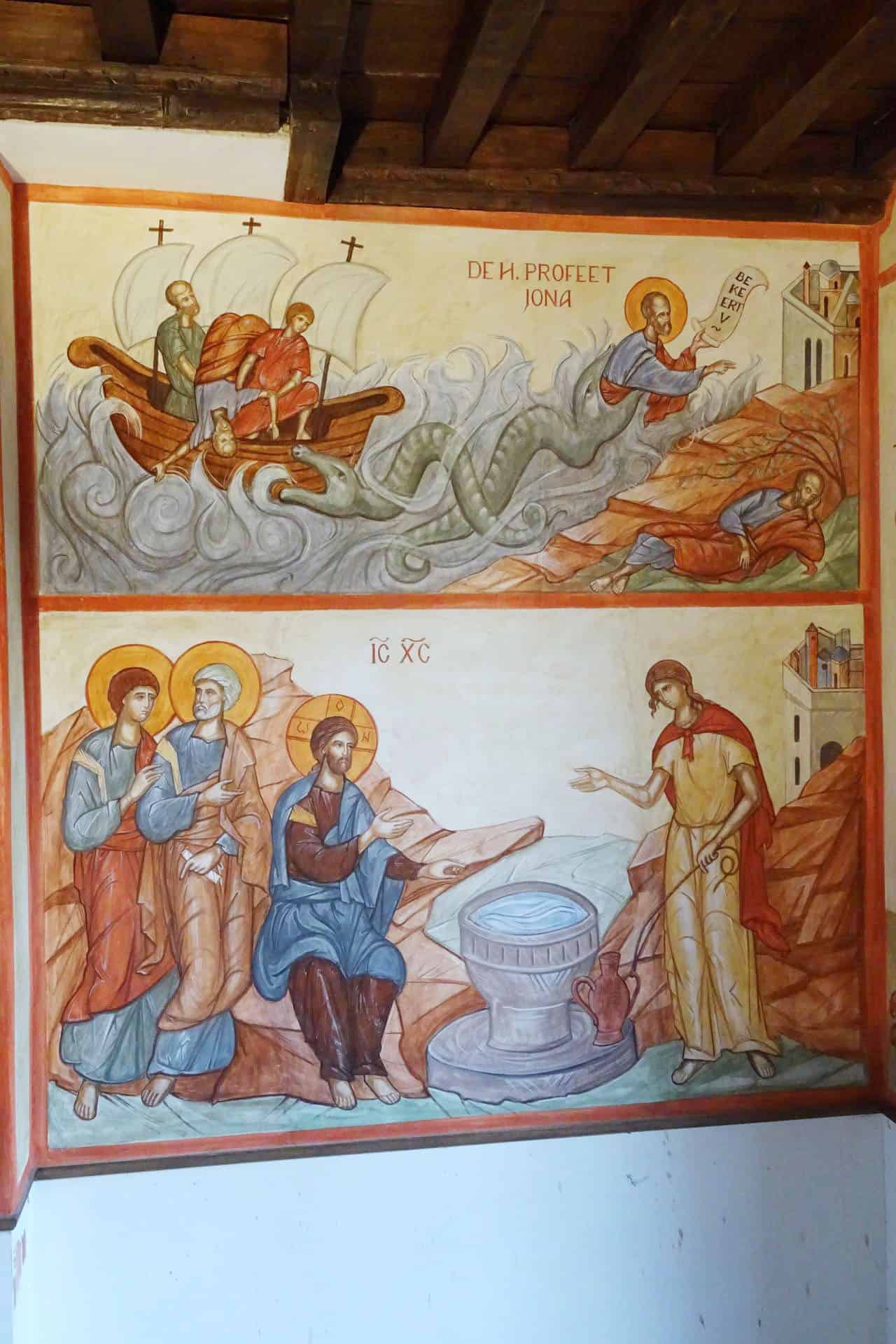
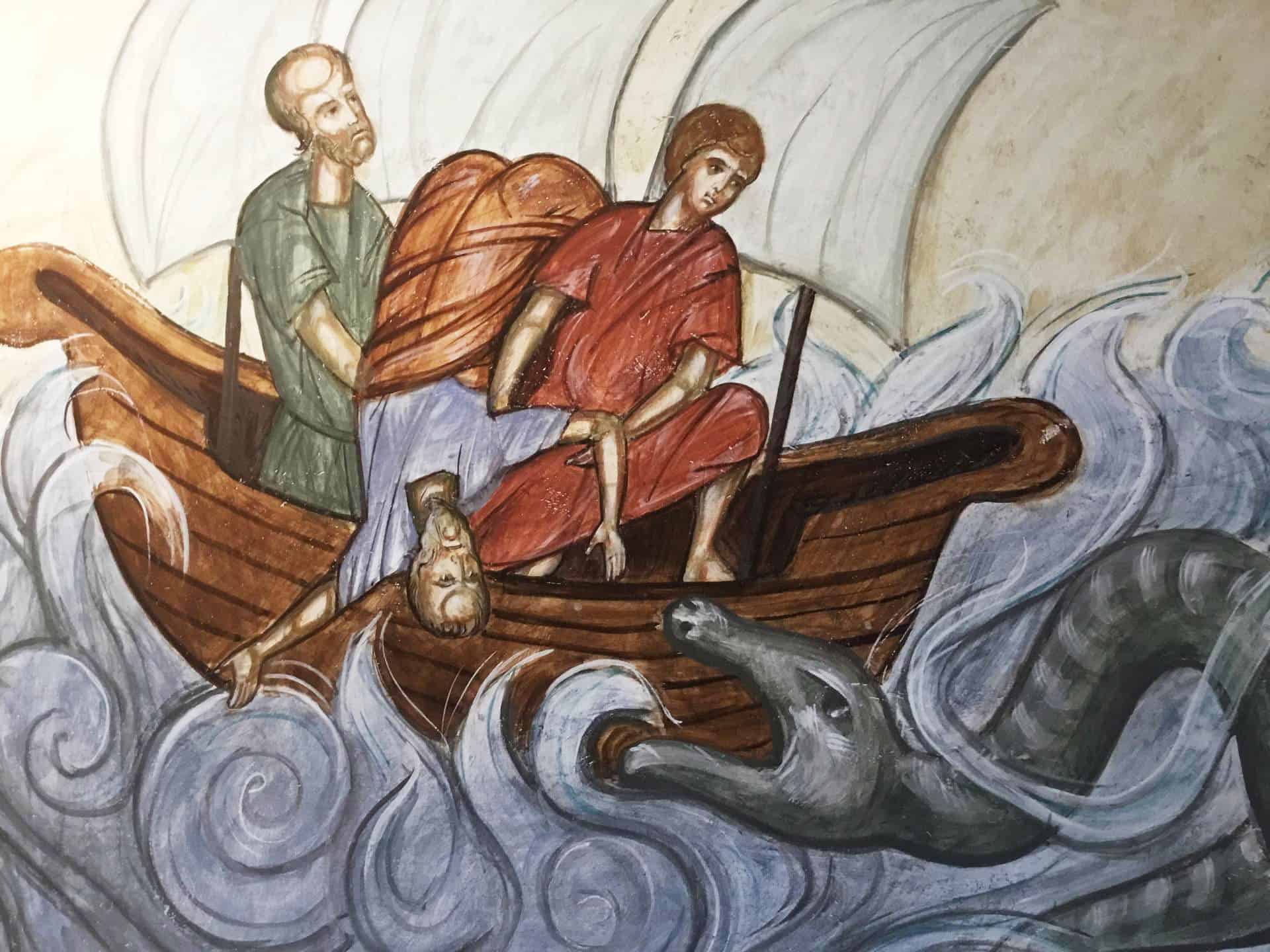
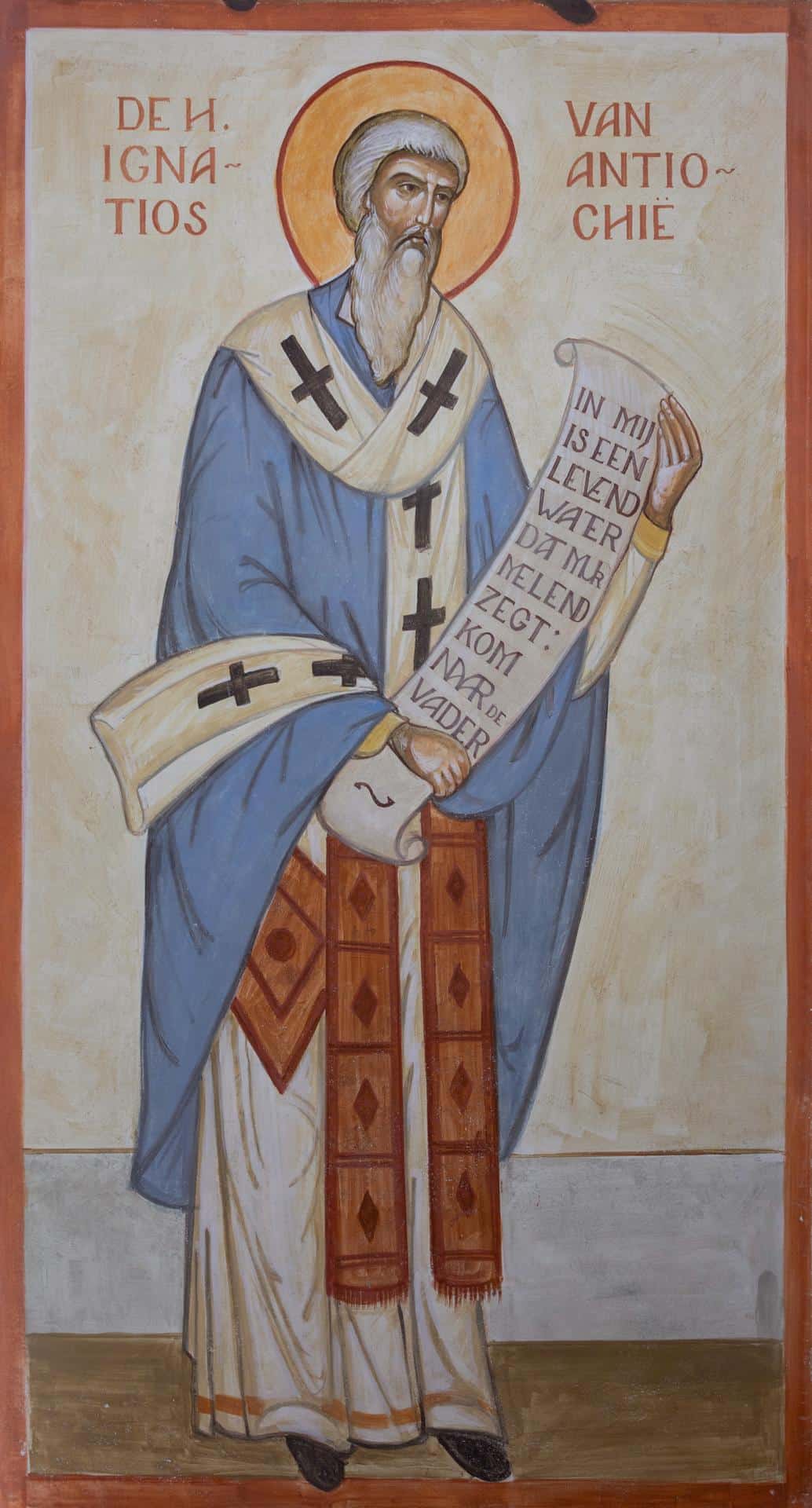
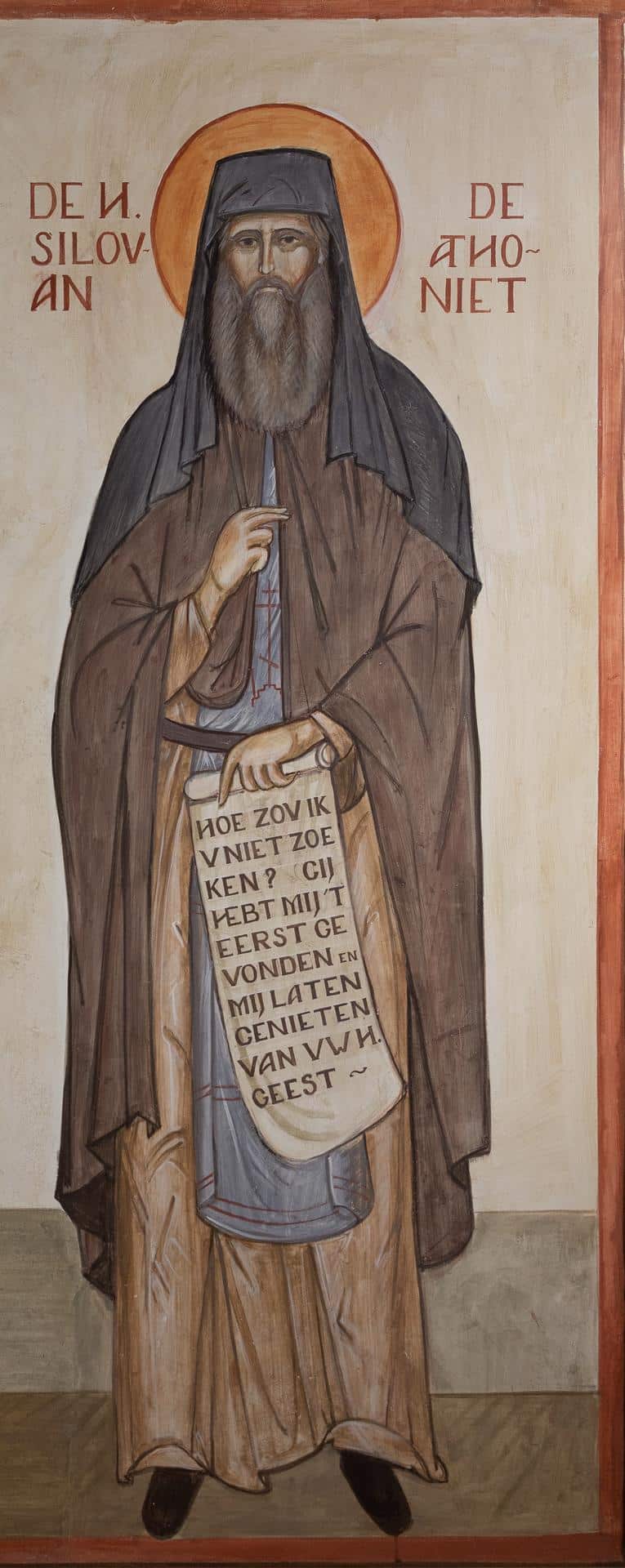

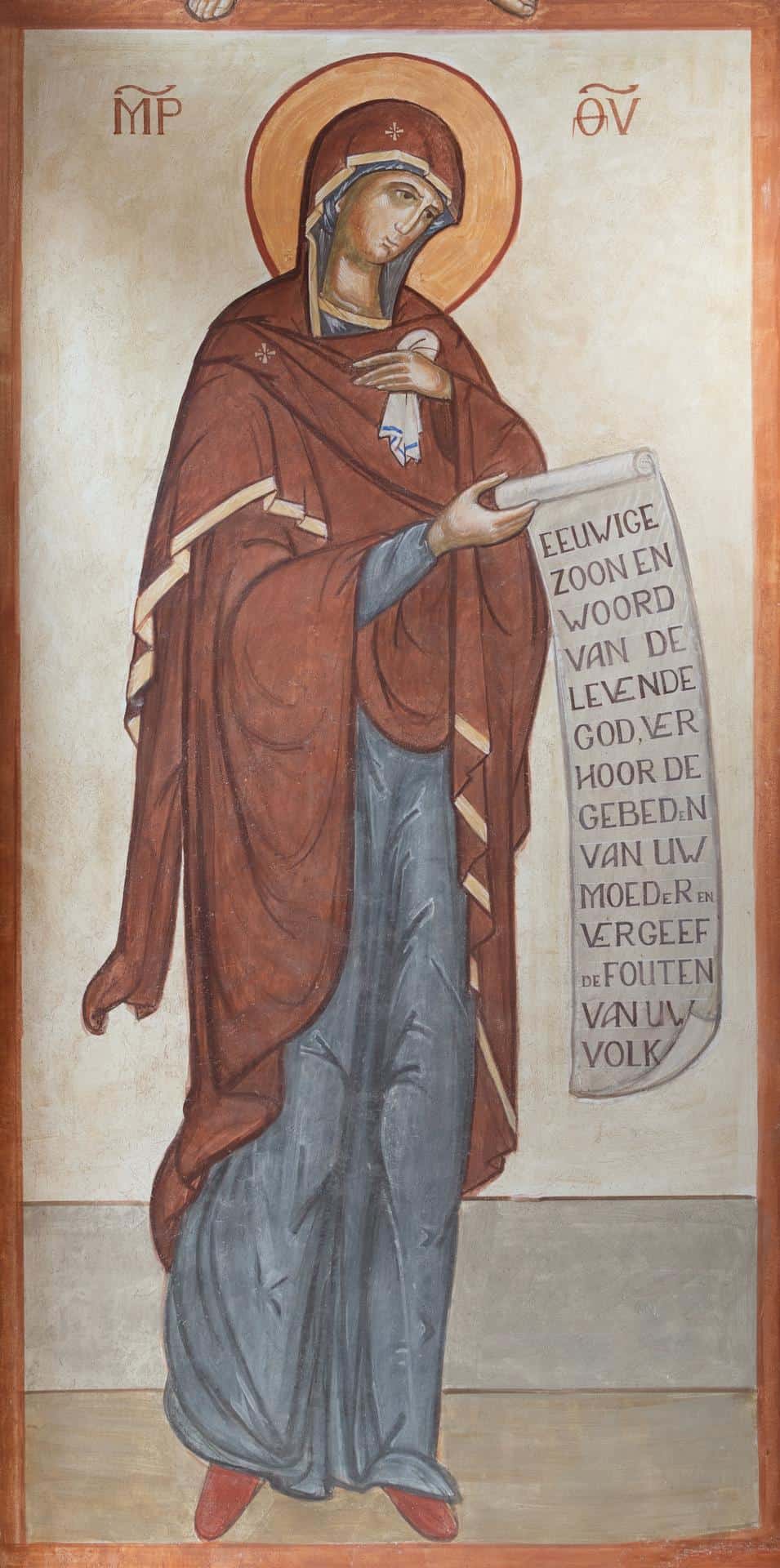
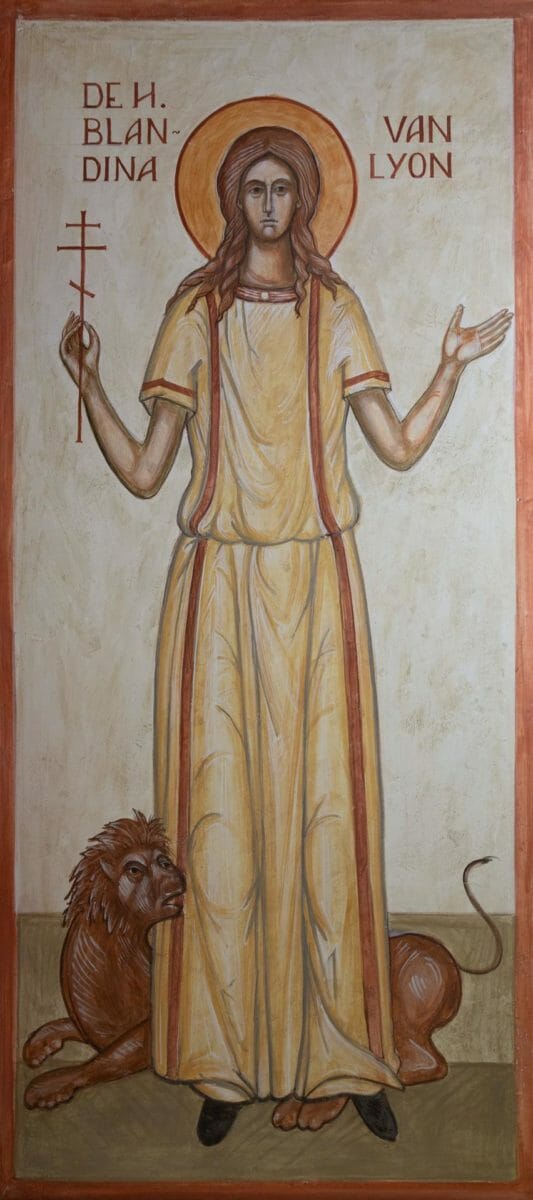










Thank you, Joris, for sharing this wonderful project with us. The painting is absolutely beautiful, of course. But I would like to say in particular how much joy it gives me to see this kind of liturgical beauty set within an old Flemish interior, with the thick walls, beamed ceiling, and tiled floor. It’s such a splendid space, right out of a painting by Rembrandt or Vermeer. Perhaps living in Belgium, you are so accustomed to rooms like this that you hardly notice them. But here in America, a room like this is a rare treasure. How wonderful it can be put to service in the Orthodox liturgy, and adorned with your profound iconography.
Thank you Joris, for this beautiful work and for sharing it with us.
The frescoes are not only beautiful, peaceful and harmonious, but also speaking to the heart and deeply moving – even through photographs.
Thank You, Verena
Remembering the periods in Averbode together with Odile, wholehearted greatings to You. … Joris
Thank you for sharing! Trully wonderfull work, inspiring!
The utter harmony in color of the frescos and the room’s woodwork and tile floors truly provide a space of prayer. Van Eal’s use of the full range in ochres is perfect for that place. Some of the “newer” modern pigments would have jolted the harmony he has created out of existence. It is an intimate space which the frescos only enhance, especially with the completing element of worship shown in the photographs. Thank you for making such beauty.
Thank You for Your appreciation. Joris Van Ael
Thanks you so much for this sharing – wonderful work!
All blessings!
Dear Joris,
Congratulations!
It is all very beautiful and prayerful.
You have managed to retain, and even further, the very special atmosphere of this first place of prayer in Ghent.
The description of your work process is both inspiring and instructive.
The preparatory drawings and sketches are words of art in their own right.
Thank you very much for sharing your treasures.
Thanks, amazing:
The teaching moment in a chapel, where you experience: being welcome with the Saints among the saints of the Orthodox Parish Saint Andrew in Ghent. This chapel should already be listed on the international monument list; definitely a tourist attraction.
This is far ahead of its time in the present, a richness added to the culture of the Orthodox Faith in Belgium.
Dank U Lucas en Svetlana voor dit fijne commentaar.
Joris